Arctic Cat ZR-XF-M 9000 2017 Service Manual
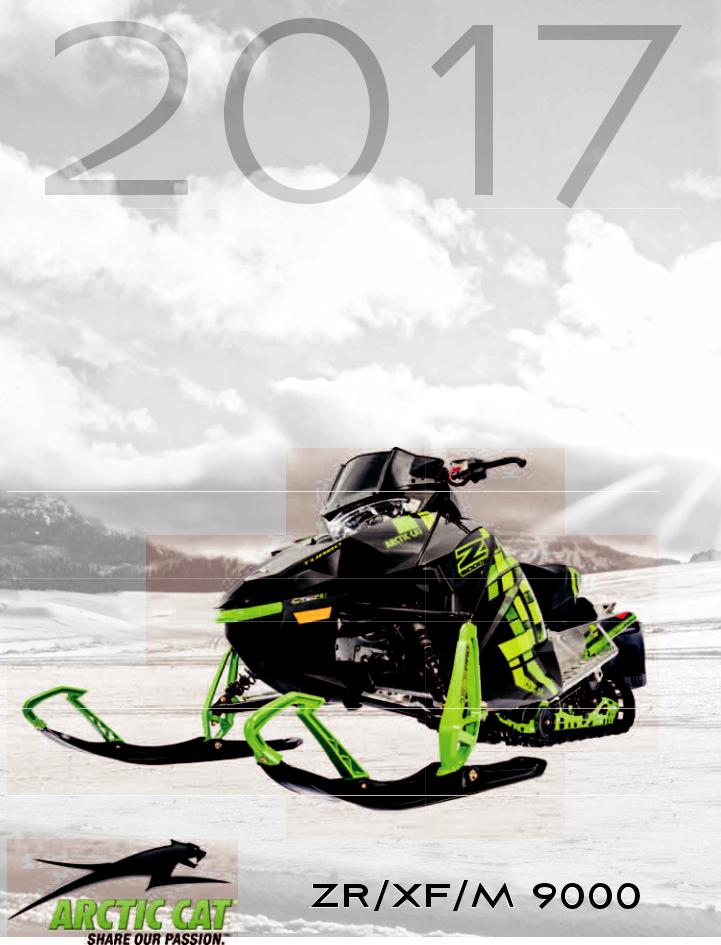
2017
SERVICE MANUAL
www.arcticcat.com
ZR/XF/M 9000
TABLE OF CONTENTS
General Information/Foreword .................................................. |
2 |
Snowmobile Identification ..................................................... |
2 |
Recommended Gasoline and Oil .......................................... |
2 |
Engine Break-In .................................................................... |
2 |
Drive Belt Break-In ................................................................ |
3 |
Genuine Parts ....................................................................... |
3 |
Preparation For Storage........................................................ |
3 |
Preparation After Storage ..................................................... |
4 |
After Break-In Checkup/Checklist ......................................... |
4 |
Engine Specifications............................................................ |
5 |
Electrical Specifications ........................................................ |
5 |
Drive Clutch/Driven Clutch-Related Specifications ............... |
6 |
Drive System Components ................................................... |
6 |
Drive System Specifications.................................................. |
6 |
Chain Case Performance Calibrations .................................. |
7 |
Track Specifications .............................................................. |
9 |
Torque Conversions .............................................................. |
9 |
Torque Specifications .......................................................... |
10 |
Steering and Body .................................................................... |
11 |
Steering Post....................................................................... |
11 |
Ski (ZR/XF) ......................................................................... |
12 |
Ski (XF HC/M)..................................................................... |
13 |
Ski Wear Bar ....................................................................... |
13 |
Spindle (ZR/XF) .................................................................. |
14 |
Spindle (XF HC/M).............................................................. |
14 |
Steering Tie Rod ................................................................. |
15 |
Ski Alignment ...................................................................... |
16 |
A-Arms (ZR/XF) .................................................................. |
17 |
A-Arms (XF HC/M).............................................................. |
18 |
Ski Shock Absorber............................................................. |
20 |
Sway Bar............................................................................. |
20 |
Front Bumper ...................................................................... |
20 |
Seat Assembly .................................................................... |
21 |
Seat Cushion ...................................................................... |
21 |
Taillight/Brakelight Assembly............................................... |
21 |
Rear Bumper/Snowflap ....................................................... |
22 |
Windshield/Console/ Headlight ........................................... |
22 |
Adjusting Headlight Aim ..................................................... |
23 |
Engine ........................................................................................ |
24 |
Engine Removing/ Installing................................................ |
24 |
Engine Servicing ................................................................. |
33 |
Assembly Schematic - 9000................................................ |
55 |
Troubleshooting Engine....................................................... |
57 |
Engine-Related Items ............................................................... |
59 |
Water Pump ........................................................................ |
59 |
Pressure Testing Engine ..................................................... |
61 |
Checking Compression ....................................................... |
61 |
Changing Engine Oil/Filter .................................................. |
61 |
Testing Oil Pressure............................................................ |
62 |
Liquid Cooling System ........................................................ |
62 |
Cooling System Schematic ................................................. |
63 |
Heat Exchanger .................................................................. |
63 |
Air Silencer.......................................................................... |
65 |
Turbocharger/Intercooler..................................................... |
65 |
Fuel Systems............................................................................. |
70 |
Fuel System ........................................................................ |
70 |
Individual Components........................................................ |
70 |
Self-Diagnostic System/Codes............................................ |
72 |
Throttle Body Assembly ...................................................... |
73 |
Throttle Cable...................................................................... |
75 |
Fuel Pump........................................................................... |
75 |
Gas Tank ............................................................................. |
77 |
Troubleshooting................................................................... |
78 |
Electrical Systems .................................................................... |
79 |
Ignition System.................................................................... |
79 |
Throttle Position Sensor...................................................... |
79 |
Electrical Resistance Tests ................................................. |
80 |
Voltage Regulator Tests ...................................................... |
81 |
Testing Fuel Gauge Sender ................................................ |
81 |
Emergency Stop Switch ...................................................... |
82 |
Starter Relay Solenoid ........................................................ |
82 |
Fuse .................................................................................... |
82 |
Ignition Switch..................................................................... |
82 |
Starter Motor ....................................................................... |
83 |
Troubleshooting Electric Start ............................................. |
84 |
Magneto .............................................................................. |
84 |
Brakelight Switch................................................................. |
86 |
Headlight Dimmer Switch.................................................... |
86 |
Testing Handlebar Warmer Elements ................................ |
86 |
Testing Thumb Warmer Element......................................... |
87 |
Testing Handlebar Warmer/Thumb Warmer Switch............ |
87 |
Testing Passenger Handwarmer Switch ............................. |
87 |
Testing Passenger Handwarmer Elements ......................... |
88 |
Testing Seat Heater Switches ............................................. |
88 |
Testing Speedometer Sensor.............................................. |
88 |
Testing Gear Position Switch............................................... |
89 |
Testing Shift Switch ............................................................. |
89 |
Testing Shift Actuator .......................................................... |
89 |
Voltage/Resistance Chart - Air Temperature....................... |
90 |
Voltage/Resistance Chart - Coolant Temperature............... |
90 |
Drive Train/Track/Brake Systems ............................................ |
91 |
Drive Belt............................................................................. |
91 |
Drive Clutch......................................................................... |
91 |
Driven Clutch....................................................................... |
93 |
Drive Clutch/Driven Clutch .................................................. |
95 |
Drive Train ........................................................................... |
96 |
Drive Sprockets................................................................. |
100 |
Track Tension .................................................................... |
102 |
Track Alignment................................................................. |
103 |
Brake System (Hydraulic) ................................................. |
104 |
Brake Lever/Master Cylinder Assembly ............................ |
109 |
Troubleshooting Drive Clutch/Driven Clutch...................... |
111 |
Troubleshooting Track ....................................................... |
112 |
Troubleshooting Hydraulic Brake System.......................... |
112 |
Suspension.............................................................................. |
113 |
Suspension Setup Basics ................................................. |
113 |
Servicing Suspension ....................................................... |
118 |
FOX Air Shocks................................................................. |
128 |
1
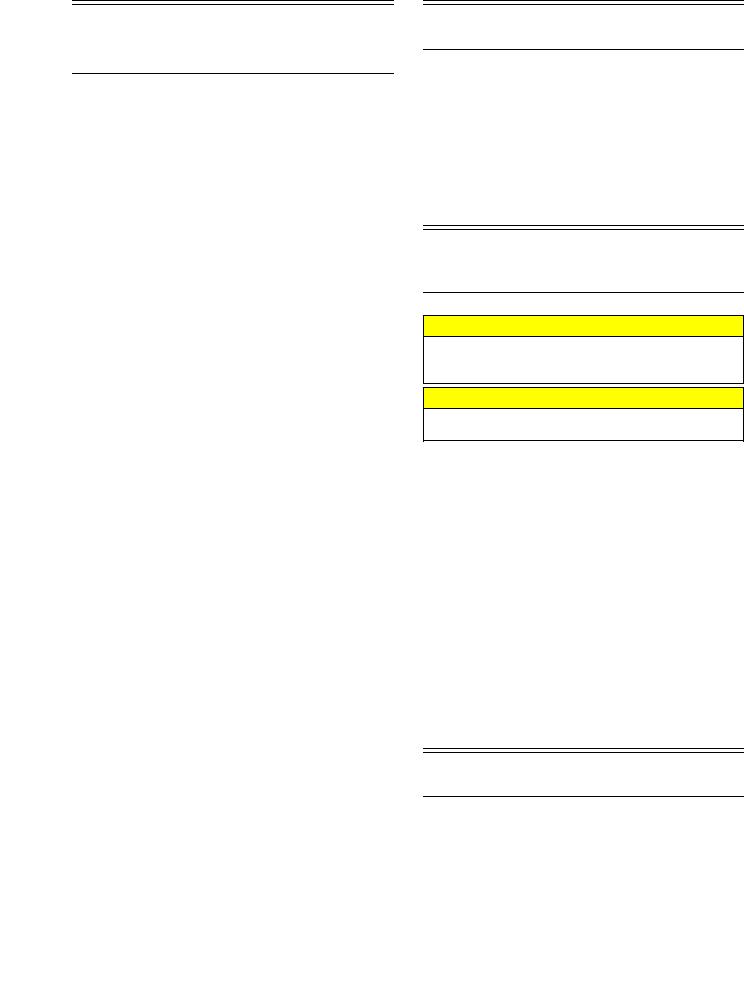
General
Information/Foreword
NOTE: General specifications for each 2017 Arctic
Cat Snowmobile can be accessed from the Arctic Cat Cat Tracker Dealer Communication System online.
NOTE: Some illustrations and photographs used in this manual are used for clarity purposes only and are not designed to depict actual conditions.
This Arctic Cat Service Manual contains service and maintenance information for certain Model Year 2017 Arctic Cat Snowmobiles (see cover). The manual is designed to aid service personnel in service-oriented applications.
This manual is divided into sections. The sections cover specific snowmobile components or systems and, in addition to the standard service procedures, includes assembling, disassembling, and inspecting instructions. When using this manual as a guide, the technician should use discretion as to how much disassembly is needed to correct any given condition.
The service technician should become familiar with the operation and construction of the components or systems by carefully studying the complete manual. This will assist the service technician in becoming more aware of and efficient with servicing procedures. Such efficiency not only helps build consumer confidence but also saves time and labor.
All Arctic Cat publications and snowmobile decals display the words Warning, Caution, and Note to emphasize important information. The symbol ! WARNING identifies personal safety-related information. Be sure to follow the directive because it deals with the possibility of severe personal injury or even death. A CAUTION identifies unsafe practices which may result in snowmo- bile-related damage. Follow the directive because it deals with the possibility of damaging part or parts of the snowmobile. The symbol NOTE: identifies supplementary information worthy of particular attention.
At the time of publication, all information, photographs, and illustrations were technically correct. Some photographs and illustrations used in this manual are used for clarity purposes only and are not designed to depict actual conditions. Because Arctic Cat Inc. constantly refines and improves its products, no retroactive obligation is incurred.
All materials and specifications are subject to change without notice.
Keep this manual accessible in the shop area for reference.
Product Service and Warranty Department Arctic Cat Inc.
Snowmobile Identification
The Arctic Cat Snowmobile has two important identification numbers. The Vehicle Identification Number (VIN) is stamped into the tunnel near the right-side footrest or on top of the tunnel. The decal also displays pertinent production information. The Engine Serial Number (ESN) is stamped into the crankcase of the engine.
These numbers are required to complete warranty claims properly. No warranty will be allowed by Arctic Cat if the engine serial number or VIN is removed or mutilated in any way.
Recommended Gasoline
and Oil
CAUTION
Do not use white gas or gasoline containing methanol. Only Arctic Cat approved gasoline additives should be used.
CAUTION
Any oil used in place of the recommended oil may cause serious damage.
RECOMMENDED GASOLINE
The recommended gasoline to use in these snowmobiles is 91 octane (minimum).
NOTE: If a situation arises in which 91 octane gasoline is not available, 87 octane gasoline can be substituted; however, do not prolong the usage of 87 octane gasoline as it will cause poor engine performance.
In many areas, oxygenates are added to the gasoline. Oxygenated gasolines containing up to 10% ethanol are acceptable gasolines. Do not use gasolines containing methanol.
RECOMMENDED OIL
The recommended oil to use is Synthetic C-TEC4 Oil (p/n 6639-529 - gal.).
After the engine break-in period, the engine oil and oil filter should be changed every 2500 miles or before prolonged storage.
Engine Break-In
The engine (when new or rebuilt) requires a short break-in period before the engine is subjected to heavy load conditions.
This engine does not require any pre-mixed fuel during the break-in period.
There is never a more important period in the life of the engine than the first 500 km (300 miles).
2
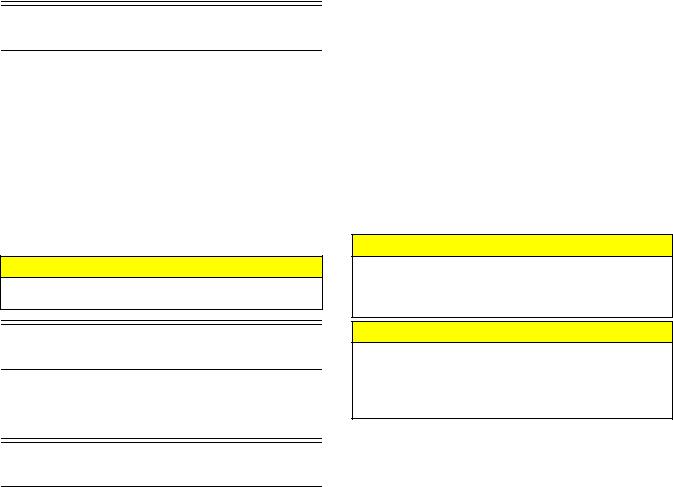
Since the engine is brand new, do not put an excessive load on it for the first 500 km (300 miles). The various parts in the engine wear and polish themselves to the correct operating clearances. During this period, prolonged full throttle operation or any condition that might result in engine overheating must be avoided.
Operating your snowmobile for the first time: Start the engine and let it idle for 5 minutes.
0-160 km (0–100 miles): Avoid prolonged operation above 6000 RPM.
160-500 km (100–300 miles): Avoid prolonged operation above 8000 RPM.
500 km (300 miles) and beyond: The snowmobile can now be operated normally.
NOTE: After 800 km (500 miles) of operation, the engine oil must be changed and the oil filter replaced. If any engine trouble should occur during the engine break-in period, immediately have an Arctic Cat dealer check the snowmobile.
Drive Belt Break-In
Drive belts require a break-in period of 25 miles. Drive the snowmobile for 25 miles at 3/4 throttle or less. By revving the engine up and down (but not exceeding 60 mph), the exposed cord on the side of a new belt will be worn down. This will allow the drive belt to gain its optimum flexibility and will extend drive belt life.
NOTE: Before starting the snowmobile in extremely cold temperatures, the drive belt should be removed and warmed up to room temperature. Once the drive belt is at room temperature, install the drive belt (see Drive Belt sub-section in the Drive Train/Track/Brake Systems section of this manual).
CAUTION
Running the engine with the drive belt removed could result in serious engine damage and drive clutch failure.
Genuine Parts
When replacement of parts is necessary, use only genuine Arctic Cat parts. They are precision-made to ensure high quality and correct fit.
Preparation For Storage
Prior to storing the snowmobile, it must be properly serviced to prevent corrosion and component deterioration.
1.Clean the seat cushion with a damp cloth and Arctic Cat Vinyl Protectant.
2.Clean the snowmobile thoroughly by hosing dirt, oil, grass, and other foreign matter from the skid frame, tunnel, hood, and belly pan. Allow the snowmobile to dry thoroughly. DO NOT get water into any part of the engine.
3.Change the engine oil and replace the air filter if necessary.
4.Fill the gas tank to its rated capacity; then add Arctic Cat Fuel Stabilizer to the gas tank following directions on the container for the stabilizer/gasoline ratio. Tighten the gas tank cap securely.
5.With the snowmobile level, check the lubricant level in the chain case. If low, add chain lube through the fill hole (when the reverse actuator is removed).
6.Remove the drive belt from the drive clutch/driven clutch. Lay the belt on a flat surface or slide it into a cardboard sleeve to prevent warping or distortion during storage; then clean and inspect the drive clutch and driven clutch.
7.Apply light oil to the upper steering post bushings and to the shafts of the shock absorbers; then lubricate the rear suspension with an all-temperature grease.
8.Tighten all nuts, bolts, and cap screws making sure all calibrated nuts, bolts, and cap screws are tightened to specifications. Make sure all rivets holding the components together are tight. Replace all loose rivets.
9.Clean and polish the hood, console, and chassis with Cat Cleaner. DO NOT USE SOLVENTS. THE PROPELLENT WILL DAMAGE THE FINISH.
10.Disconnect the battery cables making sure to disconnect the negative cable first; then clean the battery posts and cables.
CAUTION
Sealed batteries require charging if left for extended non-start periods. Arctic Cat recommends trickle charging once a month. Follow the manufacturer’s instructions and cautions.
CAUTION
On models with remote start, make sure to leave the battery cables disconnected. Failure to disconnect the battery cables when storing the snowmobile for a prolonged period of time (six weeks or more) will result in a discharged or damaged battery.
11.If possible, store the snowmobile indoors. Raise the track off the floor by blocking up the back end making sure the snowmobile is secure. Loosen the track adjusting bolts to reduce track tension. Cover the snowmobile with a machine cover or a heavy, ventilated tarpaulin to protect it from dirt and dust.
3
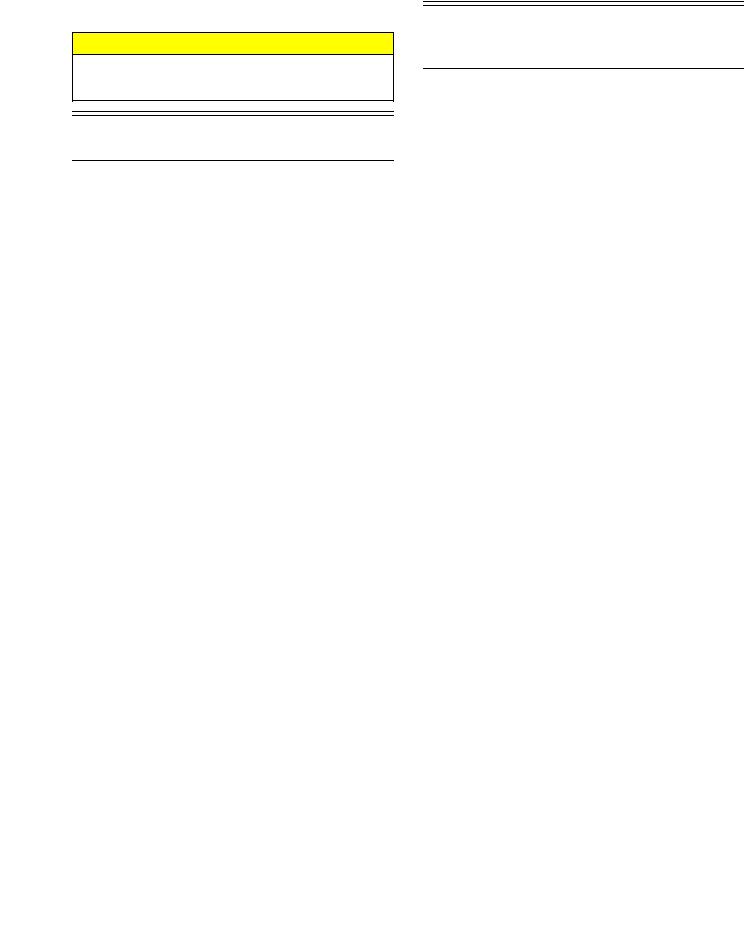
12.If the snowmobile must be stored outdoors, position the snowmobile out of direct sunlight; then block the entire snowmobile off the ground making sure the snowmobile is secure. Loosen the track adjusting bolts to reduce track tension. Cover with a machine cover or a heavy, ventilated tarpaulin to protect it from dirt, dust, and rain.
CAUTION
Avoid storing in direct sunlight and using a plastic cover as moisture may collect on the snowmobile causing corrosion.
Preparation After Storage
Taking the snowmobile out of storage and correctly preparing it for another season will assure many miles and hours of trouble-free snowmobiling. Arctic Cat recommends the following procedure:
1.Clean the snowmobile thoroughly. Polish the exterior of the snowmobile.
2.Clean the engine. Check exhaust system and air silencer for obstructions.
3.Inspect all control wires and cables for signs of wear or fraying. Replace if necessary. Use cable ties or tape to route wires and cables away from hot or rotating parts.
4.Inspect the drive belt for cracks and tears. Check belt specifications. Replace if damaged or worn. Install the drive belt (see the Drive Train/Track/Brake Systems section).
NOTE: If the old belt is worn but in reasonable condition, retain it with the snowmobile as a spare in case of emergency.
5.Adjust the throttle cable. Inspect all fuel hoses and oil hoses for deterioration or cracks; replace if necessary. Make sure all connections are tight.
6.Tighten all nuts, bolts, and cap screws making sure all calibrated nuts, bolts, and cap screws are tightened to specifications.
7.If not done during preparation for storage, lubricate the rear suspension with an all-temperature grease.
8.Check the coolant level and all coolant hoses and connections for deterioration or cracks. Add properly mixed coolant as necessary.
9.Charge the battery; then connect the battery cables making sure to connect the positive cable first. Test the electric start system.
10.Inspect the entire brake system, all controls, headlight, taillight, brake light, ski wear bars, and headlight aim; adjust or replace as necessary.
11.Adjust the track to the proper tension and alignment.
After Break-In
Checkup/Checklist
Certain areas require adjustment after the break-in period in order to obtain peak performance. These areas are the following.
DRIVE CLUTCH/DRIVEN CLUTCH ALIGNMENT — The alignment between the drive clutch and driven clutch are set at the factory. Normally, no adjustment is necessary; however, if premature drive belt wear or poor performance is experienced, the drive clutch/driven clutch alignment must be checked.
TRACK TENSION AND ALIGNMENT — A certain amount of stretch occurs on all tracks during the first 500 miles. The track must be inspected/adjusted after the first 50 to 100 miles to the specifications given in the Track Specifications sub-section of this section and periodically thereafter. If these adjustments aren’t performed, the track may “derail” which leads to track and slide rail damage.
Along with these major areas, other areas should be checked and adjusted.
Below is a list of items to check after the break-in period. The recommended mileage for this inspection is between 100 and 300 miles.
Adjust track tension and alignment
Check throttle cable tension
Check engine idle
Check coolant level
Check chain case lubricant level
Check engine oil
Check lights (high/low beam, brakelight)
Check safety switch operation
Check engine compartment for any rubbing components
Check steering hardware for tightness
Check skid frame and A-arm mounting hardware for tightness
Check brake lever travel and adjustment
Grease all lubrication points
4
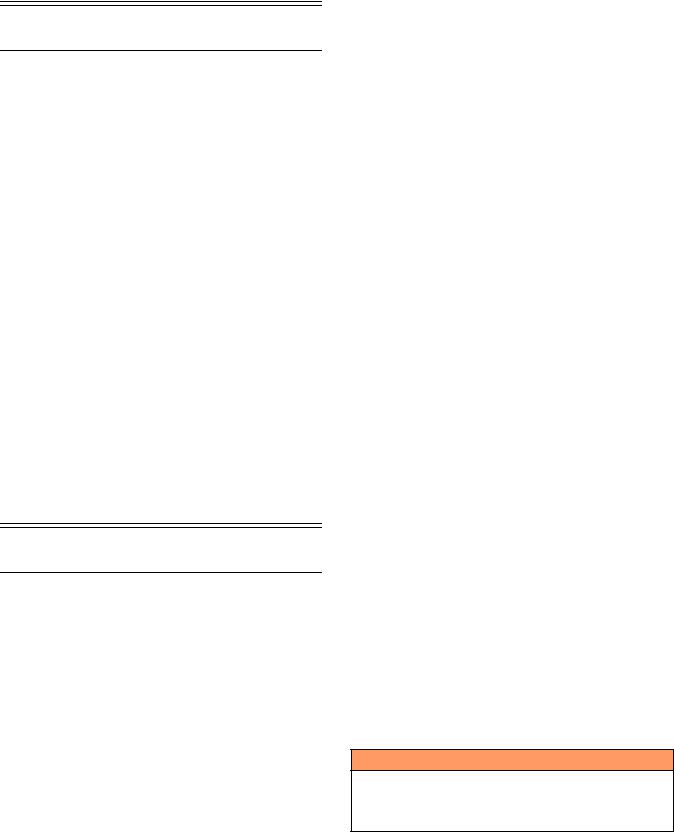
Engine Specifications
ITEM |
|
|
Engine Model Number |
|
8KJ |
Displacement |
|
998 cc |
Compression Ratio |
|
9.0:1 |
Bore x Stroke |
|
80.0 x 66.2 mm (3.15 × 2.61”) |
Cooling System |
|
Liquid |
Spark Plug (NGK) |
|
CR8E |
Spark Plug Gap |
|
0.71-0.79 mm (0.028-0.031”) |
Piston Skirt/Cylinder Clearance |
0.036-0.061 mm |
|
|
|
(0.0014-0.0024”) |
Piston Pin Diameter |
|
20.990-20.995 mm |
|
|
(0.8264-0.8266”) |
Piston Pin Bore Diameter |
|
21.004-21.015 mm |
|
|
(0.8269-0.8274”) |
Piston Pin to Piston Pin Bore Clearance |
0.009-0.025 mm |
|
|
|
(0.0003-0.0009”) |
Connecting Rod: Small End Diameter |
21.005-21.027 mm |
|
|
|
(0.8269-0.8278”) |
Crankshaft Pin/Connecting Rod Big End |
0.030-0.048 mm |
|
Clearance |
|
(0.0012-0.0019”) |
Connecting rod: Big End Diameter |
41.000-41.018 mm |
|
|
|
(1.6142-1.6149”) |
Piston Ring End Gap |
(Top) |
0.35-0.45 mm (0.014-0.018”) |
|
(2nd) |
0.75-0.85 mm (0.030-0.033”) |
|
(Oil) |
0.10-0.35 mm (0.004-0.014”) |
Piston Ring/ |
(1st - Top) |
0.030-0.065 mm |
Groove Clearance |
(2nd) |
(0.0012-0.0026”) |
|
(Oil) |
0.020-0.055 mm |
|
|
(0.0008-0.0022”) |
|
|
0.040-0.140 mm |
|
|
(0.0016-0.0055”) |
Piston Diameter |
|
79.95-79.96 mm |
(10 mm from bottom edge) |
|
(3.1476-3.1480”) |
Cam Lobe Height (Intake) |
33.750-33.850 mm |
|
(1.3287-1.3327”) |
Cam Lobe Height (Exhaust) |
33.750-33.850 mm |
|
(1.3287-1.3327”) |
Cam Lobe Width (Intake) |
24.950-25.050 mm |
|
(0.9823-0.9862”) |
Cam Lobe Width (Exhaust) |
24.950-25.050 mm |
|
(0.9823-0.9862”) |
Camshaft Journal Diameter |
24.46-24.47 mm |
|
(0.9630-0.9635”) |
Camshaft Journal Clearance |
0.028-0.062 mm |
|
(0.0011-0.0024”) |
Crank Pin Diameter |
37.976-38.000 mm |
|
(1.4951-1.4961”) |
Crankshaft Runout (max) |
0.3 mm (0.012”) |
Crankshaft Main Bearing Clearance |
0.027-0.045 mm |
|
(0.0011-0.0018”) |
Crankshaft/Rod Bearing Clearance |
0.030-0.048 mm |
|
(0.0012-0.0019”) |
Valve Stem Diameter (Intake) |
4.475-4.490 mm |
|
(0.1762-0.1677”) |
Valve Stem Diameter (Exhaust) |
4.460-4.475 mm |
|
(0.1756-0.1762”) |
Valve Guide Inside Diameter (Intake) |
4.500-4.512 mm |
|
(0.1772-0.1776”) |
Valve Guide Inside Diameter (Exhaust) |
4.500-4.512 mm |
|
(0.1772-0.1776”) |
Valve Guide/Stem Clearance (Intake) |
0.010-0.037 mm |
|
(0.0004-0.0015”) |
Valve Guide/Stem Clearance (Exhaust) |
0.025-0.052 mm |
|
(0.0010-0.0020”) |
Valve Face Width (Intake) |
0.90-1.10 mm (0.035-0.043”) |
|
|
Valve Face Width (Exhaust) |
0.90-1.10 mm (0.035-0.043”) |
VALVE TIMING (below) |
|
Intake Open (BTDC) |
35.0 degrees |
Intake Closed (ABDC) |
45.0 degrees |
Exhaust Open (BBDC) |
45.0 degrees |
Exhaust Closed (ATDC) |
35.0 degrees |
Valve Overlap |
70.0 degrees |
Electrical Specifications
Component |
Test Value |
|
+ Test Connections - |
|
|
(Normally Closed Ignition) |
|
|
|
Magneto Coil (3 tests)* |
0.15-0.23 ohm |
white |
|
white |
Primary Ignition Coil* |
1.19-1.61 ohms |
|
|
|
|
|
|
|
|
Secondary Ignition Coil* |
8.5k-11.5k ohms |
|
|
|
Crankshaft Position Sensor |
336-504 ohms |
light gray |
|
dark gray |
|
|
|
|
|
Voltage Regulator/Rectifier** |
12-14.5 DC Volts |
terminal |
|
terminal |
|
|
|
|
|
Magneto Coil (no load) |
36-44 AC Volts |
white |
|
white |
Ignition Switch |
Less than 1 ohm (key in ON position) |
terminal |
|
terminal |
* Harness plugged in |
NOTE: Lighting coil output is unregulated voltage. |
|||
! WARNING
Most voltages generated by the ignition system are sufficient to interrupt pacemakers! All technicians, especially those using pacemakers, must avoid contact with all electrical connections.
5
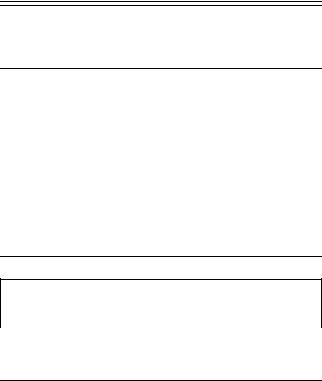
Drive System
Specifications
Model |
Drive Clutch |
Cam Arm |
Driven Clutch |
|
Torque |
Drive |
Engagement |
Peak |
Top |
Bottom |
Chain |
|
Spring |
|
Spring |
|
Bracket |
Belt |
RPM |
RPM |
Gear |
Gear |
Pitch |
ZR 9000 |
120/285 lb |
J14-74g |
155-220 lb |
|
58-49-.15 |
0627-104 |
4-4200 |
8750 |
24T |
50T |
92 |
|
|
|
|
|
|
|
|
|
|
|
|
XF 9000 |
120/285 lb |
J14-74g |
155-220 lb |
|
58-49-.15 |
0627-104 |
4-4200 |
8750 |
22T |
48T |
90 |
|
|
|
|
|
|
|
|
|
|
|
|
M 9000 King Cat |
120/285 lb |
J14-74g |
155-220 lb |
|
58-49-.15 |
0627-104 |
4-4200 |
8750 |
21T |
52T |
98 |
|
|
|
|
|
|
|
|
|
|
|
|
|
|
|
|
|
|
|
|
|
|
|
|
|
|
|
|
|
|
|
|
|
|
|
|
Drive Clutch/Driven
Clutch-Related
Specifications
ALIGNMENT BAR
CENTER-TO-CENTER |
OFFSET |
FLOAT |
|
|
|
10.38” ± 0.020” |
1.560” |
None |
|
|
|
|
|
|
|
|
|
Drive System Components
A list of Drive System components that are available through the Arctic Cat Service Parts Department can be found in the Quick Reference Guide. This information will be useful when doing any fine-tuning on the drive system.
6

Chain Case Performance
Calibrations
Drive |
Gear |
Ratio |
Chain |
|
|
|
|
|
|
Engine RPM |
|
|
|
|
|
|
||||
Sprocket |
Ratio |
|
|
|
|
|
|
|
|
|
|
|
|
|||||||
|
|
|
|
|
|
|
|
|
|
|
|
|
|
|
|
|
|
|||
|
|
|
|
|
|
|
|
|
|
|
|
|
|
|
|
|
|
|
|
|
|
Top |
Btm |
|
|
6200 |
6400 |
6600 |
6800 |
7000 |
7200 |
7400 |
7600 |
7800 |
|
8000 |
8200 |
8400 |
8600 |
8800 |
9000 |
|
|
|
|
|
|
|
|
|
|
|
|
|
|
|
|
|
|
|
||
|
|
|
|
|
|
|
|
|
Vehicle Speed (mph) |
|
|
|
|
|
|
|||||
|
|
|
|
|
|
|
|
|
|
|
|
|
|
|
|
|
||||
7 Tooth |
21 |
49 |
0.429 |
90 |
59 |
61 |
63 |
65 |
67 |
69 |
71 |
73 |
74 |
|
76 |
78 |
80 |
82 |
84 |
86 |
(3.0" pitch) |
|
|
|
|
|
|
|
|
|
|
|
|
|
|
|
|
|
|
|
|
20 |
46 |
0.435 |
88 |
60 |
62 |
64 |
66 |
68 |
70 |
72 |
74 |
75 |
|
77 |
79 |
81 |
83 |
85 |
87 |
|
|
23 |
51 |
0.451 |
92 |
62 |
64 |
66 |
68 |
70 |
72 |
74 |
76 |
78 |
|
80 |
82 |
84 |
86 |
88 |
90 |
|
22 |
48 |
0.458 |
90 |
63 |
65 |
67 |
69 |
71 |
73 |
76 |
78 |
80 |
|
82 |
84 |
86 |
88 |
90 |
92 |
|
24 |
50 |
0.480 |
92 |
66 |
68 |
71 |
73 |
75 |
77 |
79 |
81 |
83 |
|
85 |
88 |
90 |
92 |
94 |
96 |
|
|
|
|
|
|
|
|
|
|
|
|
|
|
|
|
|
|
|
|
|
|
21 |
41 |
0.512 |
86 |
71 |
73 |
75 |
78 |
80 |
82 |
84 |
87 |
89 |
|
91 |
93 |
96 |
98 |
100 |
103 |
|
21 |
38 |
0.553 |
84 |
76 |
79 |
81 |
84 |
86 |
89 |
91 |
93 |
96 |
|
98 |
101 |
103 |
106 |
108 |
111 |
|
|
|
|
|
|
|
|
|
|
|
|
|
|
|
|
|
|
|
|
|
|
20 |
35 |
0.571 |
82 |
79 |
81 |
84 |
87 |
89 |
92 |
94 |
97 |
99 |
|
102 |
104 |
107 |
109 |
112 |
114 |
|
23 |
40 |
0.575 |
86 |
79 |
82 |
84 |
87 |
90 |
92 |
95 |
97 |
100 |
|
102 |
105 |
108 |
110 |
113 |
115 |
|
22 |
37 |
0.595 |
84 |
82 |
85 |
87 |
90 |
93 |
95 |
98 |
101 |
103 |
|
106 |
109 |
111 |
114 |
116 |
119 |
|
24 |
39 |
0.615 |
86 |
85 |
88 |
90 |
93 |
96 |
99 |
101 |
104 |
107 |
|
110 |
112 |
115 |
118 |
121 |
123 |
|
|
|
|
|
|
|
|
|
|
|
|
|
|
|
|
|
|
|
|
|
|
23 |
36 |
0.639 |
84 |
88 |
91 |
94 |
97 |
100 |
102 |
105 |
108 |
111 |
|
114 |
117 |
119 |
122 |
125 |
128 |
|
24 |
35 |
0.686 |
84 |
95 |
98 |
101 |
104 |
107 |
110 |
113 |
116 |
119 |
|
122 |
125 |
128 |
131 |
134 |
137 |
|
|
|
|
|
|
|
|
|
|
|
|
|
|
|
|
|
|
|
|
|
8 Tooth |
21 |
49 |
0.429 |
90 |
64 |
67 |
69 |
71 |
73 |
75 |
77 |
79 |
81 |
|
83 |
85 |
87 |
89 |
91 |
94 |
(2.86" |
20 |
46 |
0.435 |
88 |
65 |
67 |
70 |
72 |
74 |
76 |
78 |
80 |
82 |
|
84 |
86 |
89 |
91 |
93 |
95 |
pitch) |
|
|||||||||||||||||||
|
23 |
51 |
0.451 |
92 |
68 |
70 |
72 |
74 |
77 |
79 |
81 |
83 |
85 |
|
88 |
90 |
92 |
94 |
96 |
98 |
|
22 |
48 |
0.458 |
90 |
69 |
71 |
73 |
76 |
78 |
80 |
82 |
84 |
87 |
|
89 |
91 |
93 |
96 |
98 |
100 |
|
|
|
|
|
|
|
|
|
|
|
|
|
|
|
|
|
|
|
|
|
|
24 |
50 |
0.480 |
92 |
72 |
75 |
77 |
79 |
81 |
84 |
86 |
88 |
91 |
|
93 |
95 |
98 |
100 |
102 |
105 |
|
21 |
41 |
0.512 |
86 |
77 |
80 |
82 |
84 |
87 |
89 |
92 |
94 |
97 |
|
99 |
102 |
104 |
107 |
109 |
112 |
|
|
|
|
|
|
|
|
|
|
|
|
|
|
|
|
|
|
|
|
|
|
21 |
38 |
0.553 |
84 |
83 |
86 |
88 |
91 |
94 |
97 |
99 |
102 |
105 |
|
107 |
110 |
113 |
115 |
118 |
121 |
|
20 |
35 |
0.571 |
82 |
86 |
89 |
91 |
94 |
97 |
100 |
103 |
105 |
108 |
|
111 |
114 |
116 |
119 |
122 |
125 |
|
23 |
40 |
0.575 |
86 |
86 |
89 |
92 |
95 |
98 |
100 |
103 |
106 |
109 |
|
112 |
114 |
117 |
120 |
123 |
126 |
|
22 |
37 |
0.595 |
84 |
89 |
92 |
95 |
98 |
101 |
104 |
107 |
110 |
112 |
|
115 |
118 |
121 |
124 |
127 |
130 |
|
|
|
|
|
|
|
|
|
|
|
|
|
|
|
|
|
|
|
|
|
|
24 |
39 |
0.615 |
86 |
93 |
96 |
99 |
101 |
104 |
107 |
110 |
113 |
116 |
|
119 |
122 |
125 |
128 |
131 |
134 |
|
23 |
36 |
0.639 |
84 |
96 |
99 |
102 |
105 |
108 |
112 |
115 |
118 |
121 |
|
124 |
127 |
130 |
133 |
136 |
139 |
|
|
|
|
|
|
|
|
|
|
|
|
|
|
|
|
|
|
|
|
|
|
24 |
35 |
0.686 |
84 |
103 |
106 |
110 |
113 |
116 |
120 |
123 |
126 |
130 |
|
133 |
136 |
140 |
143 |
146 |
150 |
8 Tooth |
21 |
49 |
0.429 |
90 |
68 |
70 |
72 |
74 |
76 |
79 |
81 |
83 |
85 |
|
87 |
89 |
92 |
94 |
96 |
98 |
(3.0" pitch) |
|
|
|
|
|
|
|
|
|
|
|
|
|
|
|
|
|
|
|
|
20 |
46 |
0.435 |
88 |
69 |
71 |
73 |
75 |
77 |
80 |
82 |
84 |
86 |
|
88 |
91 |
93 |
95 |
97 |
100 |
|
|
23 |
51 |
0.451 |
92 |
71 |
73 |
76 |
78 |
80 |
83 |
85 |
87 |
89 |
|
92 |
94 |
96 |
99 |
101 |
103 |
|
|
|
|
|
|
|
|
|
|
|
|
|
|
|
|
|
|
|
|
|
|
22 |
48 |
0.458 |
90 |
72 |
75 |
77 |
79 |
82 |
84 |
86 |
89 |
91 |
|
93 |
96 |
98 |
100 |
103 |
105 |
|
24 |
50 |
0.480 |
92 |
76 |
78 |
81 |
83 |
85 |
88 |
90 |
93 |
95 |
|
98 |
100 |
103 |
105 |
107 |
110 |
|
|
|
|
|
|
|
|
|
|
|
|
|
|
|
|
|
|
|
|
|
|
21 |
41 |
0.512 |
86 |
81 |
83 |
86 |
89 |
91 |
94 |
96 |
99 |
102 |
|
104 |
107 |
109 |
112 |
115 |
117 |
|
21 |
38 |
0.553 |
84 |
87 |
90 |
93 |
96 |
98 |
101 |
104 |
107 |
110 |
|
112 |
115 |
118 |
121 |
124 |
127 |
|
20 |
35 |
0.571 |
82 |
90 |
93 |
96 |
99 |
102 |
105 |
108 |
110 |
113 |
|
116 |
119 |
122 |
125 |
128 |
131 |
|
23 |
40 |
0.575 |
86 |
91 |
94 |
97 |
99 |
102 |
105 |
108 |
111 |
114 |
|
117 |
120 |
123 |
126 |
129 |
132 |
|
|
|
|
|
|
|
|
|
|
|
|
|
|
|
|
|
|
|
|
|
|
22 |
37 |
0.595 |
84 |
94 |
97 |
100 |
103 |
106 |
109 |
112 |
115 |
118 |
|
121 |
124 |
127 |
130 |
133 |
136 |
|
24 |
39 |
0.615 |
86 |
97 |
100 |
103 |
106 |
110 |
113 |
116 |
119 |
122 |
|
125 |
128 |
132 |
135 |
138 |
141 |
|
|
|
|
|
|
|
|
|
|
|
|
|
|
|
|
|
|
|
|
|
|
23 |
36 |
0.639 |
84 |
101 |
104 |
107 |
111 |
114 |
117 |
120 |
124 |
127 |
|
130 |
133 |
137 |
140 |
143 |
146 |
|
24 |
35 |
0.686 |
84 |
108 |
112 |
115 |
119 |
122 |
126 |
129 |
133 |
136 |
|
140 |
143 |
147 |
150 |
154 |
157 |
9 Tooth |
21 |
49 |
0.429 |
90 |
64 |
66 |
68 |
70 |
72 |
74 |
76 |
78 |
80 |
|
82 |
84 |
87 |
89 |
91 |
93 |
(2.52" |
20 |
46 |
0.435 |
88 |
65 |
67 |
69 |
71 |
73 |
75 |
77 |
79 |
82 |
|
84 |
86 |
88 |
90 |
92 |
94 |
pitch) |
|
|||||||||||||||||||
|
|
|
|
|
|
|
|
|
|
|
|
|
|
|
|
|
|
|
|
|
|
23 |
51 |
0.451 |
92 |
67 |
69 |
72 |
74 |
76 |
78 |
80 |
82 |
85 |
|
87 |
89 |
91 |
93 |
95 |
98 |
|
22 |
48 |
0.458 |
90 |
68 |
71 |
73 |
75 |
77 |
79 |
82 |
84 |
86 |
|
88 |
90 |
93 |
95 |
97 |
99 |
|
|
|
|
|
|
|
|
|
|
|
|
|
|
|
|
|
|
|
|
|
|
24 |
50 |
0.480 |
92 |
72 |
74 |
76 |
78 |
81 |
83 |
85 |
88 |
90 |
|
92 |
95 |
97 |
99 |
102 |
104 |
|
21 |
41 |
0.512 |
86 |
76 |
79 |
81 |
84 |
86 |
89 |
91 |
94 |
96 |
|
99 |
101 |
103 |
106 |
108 |
111 |
|
21 |
38 |
0.553 |
84 |
82 |
85 |
88 |
90 |
93 |
96 |
98 |
101 |
104 |
|
106 |
109 |
112 |
114 |
117 |
120 |
|
20 |
35 |
0.571 |
82 |
85 |
88 |
91 |
93 |
96 |
99 |
102 |
104 |
107 |
|
110 |
113 |
115 |
118 |
121 |
124 |
|
|
|
|
|
|
|
|
|
|
|
|
|
|
|
|
|
|
|
|
|
|
23 |
40 |
0.575 |
86 |
86 |
88 |
91 |
94 |
97 |
100 |
102 |
105 |
108 |
|
111 |
113 |
116 |
119 |
122 |
124 |
|
22 |
37 |
0.595 |
84 |
89 |
91 |
94 |
97 |
100 |
103 |
106 |
109 |
112 |
|
114 |
117 |
120 |
123 |
126 |
129 |
|
|
|
|
|
|
|
|
|
|
|
|
|
|
|
|
|
|
|
|
|
|
24 |
39 |
0.615 |
86 |
92 |
95 |
98 |
101 |
104 |
107 |
109 |
112 |
115 |
|
118 |
121 |
124 |
127 |
130 |
133 |
|
23 |
36 |
0.639 |
84 |
95 |
98 |
101 |
104 |
108 |
111 |
114 |
117 |
120 |
|
123 |
126 |
129 |
132 |
135 |
138 |
|
24 |
35 |
0.686 |
84 |
102 |
106 |
109 |
112 |
115 |
119 |
122 |
125 |
129 |
|
132 |
135 |
138 |
142 |
145 |
148 |
|
|
|
|
|
|
|
|
|
|
|
|
|
|
|
|
|
|
|
|
|
7
Drive |
Gear |
Ratio |
Chain |
|
|
|
|
|
|
Engine RPM |
|
|
|
|
|
|
||||
Sprocket |
Ratio |
|
|
|
|
|
|
|
|
|
|
|
|
|||||||
|
|
|
|
|
|
|
|
|
|
|
|
|
|
|
|
|
|
|||
|
Top |
Btm |
|
|
6200 |
6400 |
6600 |
6800 |
7000 |
7200 |
7400 |
7600 |
7800 |
|
8000 |
8200 |
8400 |
8600 |
8800 |
9000 |
|
|
|
|
|
|
|
|
|
Vehicle Speed (mph) |
|
|
|
|
|
|
|||||
|
|
|
|
|
|
|
|
|
|
|
|
|
|
|
|
|
||||
|
|
|
|
|
|
|
|
|
|
|
|
|
|
|
|
|
|
|
|
|
9 Tooth |
21 |
49 |
0.429 |
90 |
73 |
75 |
77 |
80 |
82 |
84 |
87 |
89 |
91 |
|
94 |
96 |
98 |
101 |
103 |
105 |
(2.86" |
20 |
46 |
0.435 |
88 |
74 |
76 |
78 |
81 |
83 |
85 |
88 |
90 |
93 |
|
95 |
97 |
100 |
102 |
104 |
107 |
pitch) |
|
|||||||||||||||||||
|
23 |
51 |
0.451 |
92 |
76 |
79 |
81 |
84 |
86 |
89 |
91 |
94 |
96 |
|
98 |
101 |
103 |
106 |
108 |
111 |
|
22 |
48 |
0.458 |
90 |
78 |
80 |
83 |
85 |
88 |
90 |
93 |
95 |
98 |
|
100 |
103 |
105 |
108 |
110 |
113 |
|
|
|
|
|
|
|
|
|
|
|
|
|
|
|
|
|
|
|
|
|
|
24 |
50 |
0.480 |
92 |
81 |
84 |
86 |
89 |
92 |
94 |
97 |
100 |
102 |
|
105 |
107 |
110 |
113 |
115 |
118 |
|
21 |
41 |
0.512 |
86 |
87 |
89 |
92 |
95 |
98 |
101 |
103 |
106 |
109 |
|
112 |
115 |
117 |
120 |
123 |
126 |
|
|
|
|
|
|
|
|
|
|
|
|
|
|
|
|
|
|
|
|
|
|
21 |
38 |
0.553 |
84 |
93 |
97 |
100 |
103 |
106 |
109 |
112 |
115 |
118 |
|
121 |
124 |
127 |
130 |
133 |
136 |
|
20 |
35 |
0.571 |
82 |
97 |
100 |
103 |
106 |
109 |
112 |
115 |
118 |
122 |
|
125 |
128 |
131 |
134 |
137 |
140 |
|
23 |
40 |
0.575 |
86 |
97 |
100 |
104 |
107 |
110 |
113 |
116 |
119 |
122 |
|
126 |
129 |
132 |
135 |
138 |
141 |
|
22 |
37 |
0.595 |
84 |
101 |
104 |
107 |
110 |
114 |
117 |
120 |
123 |
127 |
|
130 |
133 |
136 |
140 |
143 |
146 |
|
|
|
|
|
|
|
|
|
|
|
|
|
|
|
|
|
|
|
|
|
|
24 |
39 |
0.615 |
86 |
104 |
107 |
111 |
114 |
118 |
121 |
124 |
128 |
131 |
|
134 |
138 |
141 |
144 |
148 |
151 |
|
23 |
36 |
0.639 |
84 |
108 |
112 |
115 |
119 |
122 |
126 |
129 |
132 |
136 |
|
139 |
143 |
146 |
150 |
153 |
157 |
|
|
|
|
|
|
|
|
|
|
|
|
|
|
|
|
|
|
|
|
|
|
24 |
35 |
0.686 |
84 |
116 |
120 |
123 |
127 |
131 |
135 |
138 |
142 |
146 |
|
150 |
153 |
157 |
161 |
165 |
168 |
9 Tooth |
21 |
49 |
0.429 |
90 |
76 |
79 |
81 |
83 |
86 |
88 |
91 |
93 |
96 |
|
98 |
101 |
103 |
105 |
108 |
110 |
(3.0" pitch) |
|
|
|
|
|
|
|
|
|
|
|
|
|
|
|
|
|
|
|
|
20 |
46 |
0.435 |
88 |
77 |
80 |
82 |
85 |
87 |
90 |
92 |
95 |
97 |
|
100 |
102 |
105 |
107 |
110 |
112 |
|
|
23 |
51 |
0.451 |
92 |
80 |
83 |
85 |
88 |
90 |
93 |
96 |
98 |
101 |
|
103 |
106 |
108 |
111 |
114 |
116 |
|
|
|
|
|
|
|
|
|
|
|
|
|
|
|
|
|
|
|
|
|
|
22 |
48 |
0.458 |
90 |
81 |
84 |
87 |
89 |
92 |
94 |
97 |
100 |
102 |
|
105 |
108 |
110 |
113 |
115 |
118 |
|
24 |
50 |
0.480 |
92 |
85 |
88 |
91 |
93 |
96 |
99 |
102 |
104 |
107 |
|
110 |
113 |
115 |
118 |
121 |
124 |
|
|
|
|
|
|
|
|
|
|
|
|
|
|
|
|
|
|
|
|
|
|
21 |
41 |
0.512 |
86 |
91 |
94 |
97 |
100 |
103 |
106 |
108 |
111 |
114 |
|
117 |
120 |
123 |
126 |
129 |
132 |
|
21 |
38 |
0.553 |
84 |
98 |
101 |
104 |
108 |
111 |
114 |
117 |
120 |
123 |
|
127 |
130 |
133 |
136 |
139 |
142 |
|
20 |
35 |
0.571 |
82 |
101 |
105 |
108 |
111 |
114 |
118 |
121 |
124 |
128 |
|
131 |
134 |
137 |
141 |
144 |
147 |
|
23 |
40 |
0.575 |
86 |
102 |
105 |
109 |
112 |
115 |
118 |
122 |
125 |
128 |
|
132 |
135 |
138 |
142 |
145 |
148 |
|
|
|
|
|
|
|
|
|
|
|
|
|
|
|
|
|
|
|
|
|
|
22 |
37 |
0.595 |
84 |
106 |
109 |
112 |
116 |
119 |
123 |
126 |
129 |
133 |
|
136 |
140 |
143 |
146 |
150 |
153 |
|
24 |
39 |
0.615 |
86 |
109 |
113 |
116 |
120 |
123 |
127 |
130 |
134 |
137 |
|
141 |
144 |
148 |
151 |
155 |
159 |
|
|
|
|
|
|
|
|
|
|
|
|
|
|
|
|
|
|
|
|
|
|
23 |
36 |
0.639 |
84 |
113 |
117 |
121 |
124 |
128 |
132 |
135 |
139 |
143 |
|
146 |
150 |
154 |
157 |
161 |
165 |
|
24 |
35 |
0.686 |
84 |
122 |
126 |
130 |
133 |
137 |
141 |
145 |
149 |
153 |
|
157 |
161 |
165 |
169 |
173 |
177 |
10 Tooth |
21 |
49 |
0.429 |
90 |
71 |
73 |
76 |
78 |
80 |
82 |
85 |
87 |
89 |
|
92 |
94 |
96 |
98 |
101 |
103 |
(2.52" |
20 |
46 |
0.435 |
88 |
72 |
74 |
77 |
79 |
81 |
84 |
86 |
88 |
91 |
|
93 |
95 |
98 |
100 |
102 |
105 |
pitch) |
|
|||||||||||||||||||
|
|
|
|
|
|
|
|
|
|
|
|
|
|
|
|
|
|
|
|
|
|
23 |
51 |
0.451 |
92 |
75 |
77 |
80 |
82 |
84 |
87 |
89 |
92 |
94 |
|
96 |
99 |
101 |
104 |
106 |
108 |
|
22 |
48 |
0.458 |
90 |
76 |
78 |
81 |
83 |
86 |
88 |
91 |
93 |
96 |
|
98 |
100 |
103 |
105 |
108 |
110 |
|
|
|
|
|
|
|
|
|
|
|
|
|
|
|
|
|
|
|
|
|
|
24 |
50 |
0.480 |
92 |
80 |
82 |
85 |
87 |
90 |
92 |
95 |
97 |
100 |
|
103 |
105 |
108 |
110 |
113 |
115 |
|
21 |
41 |
0.512 |
86 |
85 |
88 |
90 |
93 |
96 |
99 |
101 |
104 |
107 |
|
109 |
112 |
115 |
118 |
120 |
123 |
|
21 |
38 |
0.553 |
84 |
92 |
94 |
97 |
100 |
103 |
106 |
109 |
112 |
115 |
|
118 |
121 |
124 |
127 |
130 |
133 |
|
20 |
35 |
0.571 |
82 |
95 |
98 |
101 |
104 |
107 |
110 |
113 |
116 |
119 |
|
122 |
125 |
128 |
131 |
134 |
137 |
|
|
|
|
|
|
|
|
|
|
|
|
|
|
|
|
|
|
|
|
|
|
23 |
40 |
0.575 |
86 |
95 |
98 |
101 |
104 |
108 |
111 |
114 |
117 |
120 |
|
123 |
126 |
129 |
132 |
135 |
138 |
|
22 |
37 |
0.595 |
84 |
98 |
102 |
105 |
108 |
111 |
114 |
118 |
121 |
124 |
|
127 |
130 |
133 |
137 |
140 |
143 |
|
|
|
|
|
|
|
|
|
|
|
|
|
|
|
|
|
|
|
|
|
|
24 |
39 |
0.615 |
86 |
102 |
105 |
108 |
112 |
115 |
118 |
122 |
125 |
128 |
|
132 |
135 |
138 |
141 |
145 |
148 |
|
23 |
36 |
0.639 |
84 |
106 |
109 |
113 |
116 |
119 |
123 |
126 |
130 |
133 |
|
137 |
140 |
143 |
147 |
150 |
154 |
|
24 |
35 |
0.686 |
84 |
114 |
117 |
121 |
125 |
128 |
132 |
136 |
139 |
143 |
|
147 |
150 |
154 |
158 |
161 |
165 |
|
|
|
|
|
|
|
|
|
|
|
|
|
|
|
|
|
|
|
|
|
8

Track Specifications
Carefully matching the riding requirements to the type of track will ensure the maximum use of all available engine power. Lug height and track durometer are the two main concerns when selecting a track for various riding styles.
Tracks exist with lug heights from 1.0” up to 3.0” to accommodate various snow conditions. Generally, the deeper the snow, the taller the lug. It must be noted that the installation of any deep-lug track may reduce top end speed and promote premature wear strip wear in marginal snow conditions.
Durometer is a measurement of how hard a rubber is. The lugs on most tracks range between 60 and 80 durometer. On the durometer scale, the higher the number, the harder the lugs. For riding in deep powder snow, a softer durometer track works best. The softer rubber allows the track to “give” a little and pack the snow creating lift rather than digging its way straight down. When hill-climbing, the harder lug of an 80 durometer track works the best due to penetrating the hard snow creating more bite.
Some tracks come with a dual durometer rating, such as a track with a 80/60 durometer rating. The lugs on this track are 80% 80 durometer rubber, and the top 20% is made of the softer 60 durometer rubber. This track is designed to be a good all-around track for riding mostly in deep powder snow but can climb the occasional hard snow hill.
Model |
Length |
Lug Height |
ZR |
129/137” |
1.25” |
XF |
137” |
1.25” |
|
|
|
XF High Country |
141/153” |
1.75” |
|
|
|
M 9000 King Cat |
162” |
3.0” |
|
|
|
NOTE: The track tension on all models should be
2-in. at 20 lb.
Torque Conversions
ft-lb |
N-m |
ft-lb |
N-m |
ft-lb |
N-m |
ft-lb |
N-m |
1 |
1.4 |
26 |
35.4 |
51 |
69.4 |
76 |
103.4 |
2 |
2.7 |
27 |
36.7 |
52 |
70.7 |
77 |
104.7 |
3 |
4.1 |
28 |
38.1 |
53 |
72.1 |
78 |
106.1 |
4 |
5.4 |
29 |
39.4 |
54 |
73.4 |
79 |
107.4 |
5 |
6.8 |
30 |
40.8 |
55 |
74.8 |
80 |
108.8 |
6 |
8.2 |
31 |
42.2 |
56 |
76.2 |
81 |
110.2 |
7 |
9.5 |
32 |
43.5 |
57 |
77.5 |
82 |
111.5 |
8 |
10.9 |
33 |
44.9 |
58 |
78.9 |
83 |
112.9 |
9 |
12.2 |
34 |
46.2 |
59 |
80.2 |
84 |
114.2 |
10 |
13.6 |
35 |
47.6 |
60 |
81.6 |
85 |
115.6 |
11 |
15 |
36 |
49 |
61 |
83 |
86 |
117 |
12 |
16.3 |
37 |
50.3 |
62 |
84.3 |
87 |
118.3 |
13 |
17.7 |
38 |
51.7 |
63 |
85.7 |
88 |
119.7 |
14 |
19 |
39 |
53 |
64 |
87 |
89 |
121 |
15 |
20.4 |
40 |
54.4 |
65 |
88.4 |
90 |
122.4 |
16 |
21.8 |
41 |
55.8 |
66 |
89.8 |
91 |
123.8 |
17 |
23.1 |
42 |
57.1 |
67 |
91.1 |
92 |
125.1 |
18 |
24.5 |
43 |
58.5 |
68 |
92.5 |
93 |
126.5 |
19 |
25.8 |
44 |
59.8 |
69 |
93.8 |
94 |
127.8 |
20 |
27.2 |
45 |
61.2 |
70 |
95.2 |
95 |
129.2 |
21 |
28.6 |
46 |
62.6 |
71 |
96.6 |
96 |
130.6 |
22 |
29.9 |
47 |
63.9 |
72 |
97.9 |
97 |
131.9 |
23 |
31.3 |
48 |
65.3 |
73 |
99.3 |
98 |
133.3 |
24 |
32.6 |
49 |
66.6 |
74 |
100.6 |
99 |
134.6 |
25 |
34 |
50 |
68 |
75 |
102 |
100 |
136 |
|
|
|
|
|
|
|
|
9
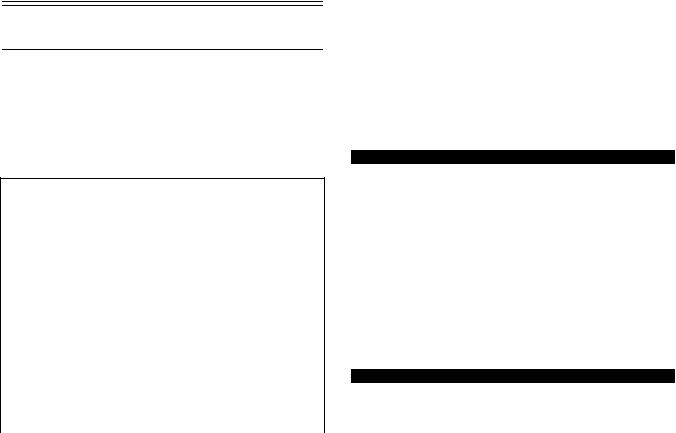
Torque Specifications
NOTE: Torque specifications have the following tolerances:
Torque (ft-lb) |
Tolerance |
0-15 |
±20% |
16-39 |
±15% |
40+ |
±10% |
DRIVE SYSTEM
Item |
|
Secured to |
Torque |
|
|||
|
ft-lb |
||
|
|
|
|
|
|
|
|
Drive Clutch |
Engine |
51**** |
|
Drive Clutch Cover |
Movable Sheave |
120 in.-lb |
|
|
|
|
|
Cam Arm Lock Nut |
Cam Arm Screw |
50 in.-lb |
|
|
|
|
|
Driven Clutch |
Driven Shaft |
60 |
|
Spider |
Stationary Sheave |
450*** |
|
|
|
|
|
Movable Sheave |
Torque Bracket |
72 in.-lb |
|
|
|
|
|
Chain Case (Cap Screw) |
Chassis |
96 in.-lb |
|
Chain Case (Torx-Head Screw) |
Chassis |
12 |
|
|
|
|
|
Chain Case Cover |
Chain Case |
12 |
|
|
|
|
|
Shift Actuator |
Chain Case Cover |
36 in.-lb |
|
Brake Caliper |
Chassis |
25** |
|
|
|
|
|
Outside Caliper Housing |
Inside Caliper Housing |
25 |
|
|
|
|
|
Brakeline |
Caliper |
25 |
|
Brakeline |
Master Cylinder |
25 |
|
|
|
|
|
Brake Caliper |
Shield Cover |
96 in.-lb** |
|
|
|
|
|
|
|
||
STEERING/FRONT SUSPENSION/CHASSIS |
|
||
Item |
|
Secured to |
Torque |
|
ft-lb |
||
|
|
|
|
Ski |
|
Spindle |
35 |
Ski |
|
Wearbar |
8 |
Ski |
|
Ski Handle |
54 in.-lb |
Handlebar Adjuster Block |
|
Post |
15 |
Steering Support |
|
Mounting Block |
8 |
Steering Tie Rod Link |
|
Steering Post |
35 |
Steering Tie Rod Link |
|
Steering Arm |
20 |
Steering Post Cap |
|
Riser Block |
15 |
Steering Post |
|
Chassis |
55 |
Steering Tie Rod |
|
Steering Arm |
20 |
Tie Rod |
|
Spindle Arm |
32 |
Steering Support |
|
Spar |
20 |
Steering Arm |
|
Chassis |
8 |
A-Arm (Upper) (XF HC/M) |
|
Chassis |
9 |
A-Arm (Upper) (ZR/XF) |
|
Chassis |
23 |
A-Arm (Lower) |
|
Chassis (Front) |
65 |
A-Arm (Lower) |
Chassis (Rear) |
45 |
A-Arm (Upper) (ZR/XF) |
Spindle |
45 |
A-Arm (Upper) (XF HC/M) |
Spindle |
23 |
A-Arm (Lower) |
Spindle |
45 |
Shock Absorber (ZR, XF) |
Spindle |
32 |
Shock Absorber (ZR, XF) |
Chassis |
32 |
Shock Absorber (XF HC/M) |
Spindle |
24 |
Shock Absorber (XF HC/M) |
Chassis |
24 |
Sway Bar Link |
A-Arm/Sway Bar Link |
23 |
Sway Bar Mounting Bracket |
Chassis |
9 |
REAR SUSPENSION |
|
|
XF 141/153/162” |
|
|
Wear Strip |
Rail |
50 in.-lb |
End Cap |
Rail |
80 in.-lb |
Mounting Block |
Rail |
12 |
Rear Wheel Axle |
Rail |
34 |
Rear Arm |
Rail |
20 |
Idler Arm |
Rear Arm |
40 |
Front Shock |
Rail |
50** |
Rear Shock |
Front Arm/Idler Arm |
40 |
Rail Support |
Rail |
20 |
Front Shock |
Front Arm |
40 |
Limiter Strap |
Rail Support |
72 in.-lb |
Rear Tri Hub Wheel |
Rear Tri Hub Wheel |
50 in.-lb |
Rear Shock Link |
Front Arm/Idler Arm |
40 |
Front Arm |
Rail |
52** |
Skid Frame |
Tunnel |
45** |
ZR/XF 129”/137” |
|
|
Wear Strip |
Rail |
50 in.-lb |
End Cap |
Rail |
80 in.-lb |
Mounting Block |
Rail |
12 |
Rear Arm |
Rail |
45 |
Rear Arm |
Idler Arm |
55 |
Spring Slide |
Rail |
20 |
Front Arm |
Rail |
52 |
Coupler Block Axle |
Rail |
40 |
Limiter Strap |
Rail Support |
72 in.-lb |
Rear Tri Hub Wheel |
Rear Tri Hub Wheel |
50 in.-lb |
Rear Wheel Axle |
Rail |
34 |
Skid Frame |
Tunnel |
45** |
Front Shock |
Rail |
50** |
Rail Support |
Rail |
20 |
Limiter Strap |
Front Arm |
72 in.-lb |
*w/Green Loctite #609
**w/Blue Loctite #243
***w/Red Loctite #271
****w/Oil
10
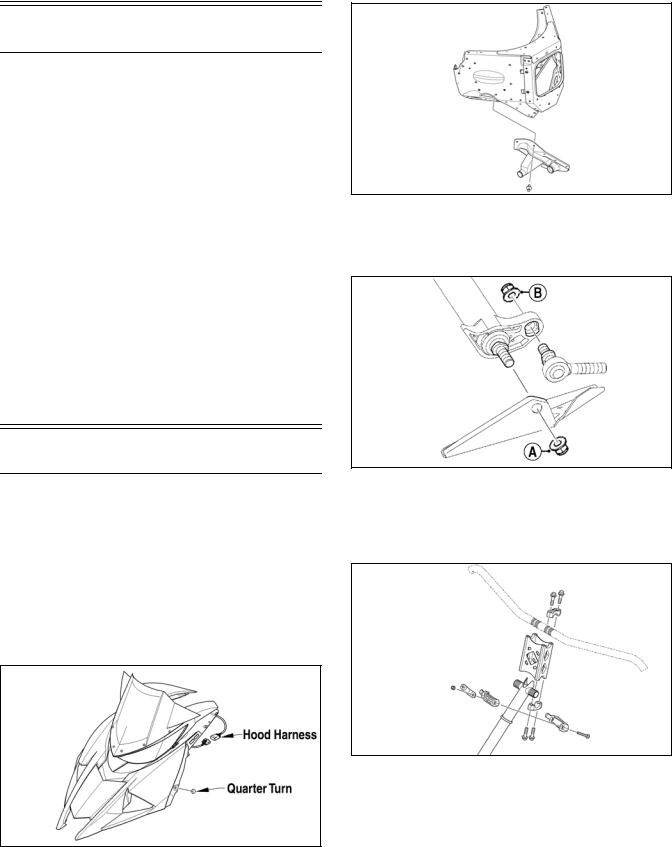
Steering and Body
This section has been organized into sub-sections for servicing steering and body components; however, some components may vary from model to model. The technician should use discretion and sound judgment when removing and installing components.
NOTE: Whenever a part is worn excessively, cracked, or damaged in any way, replacement is necessary.
SPECIAL TOOLS
A special tool must be available to the technician when servicing the steering and body systems.
NOTE: When indicated for use, each special tool will be identified by its specific name, as shown in the chart below, and capitalized.
Description |
p/n |
|
|
Handlebar Stand |
5639-152 |
|
|
Steering Post Stand |
5639-946 |
|
|
NOTE: Special tools are available from the Arctic
Cat Service Parts Department.
Steering Post
REMOVING
To remove the access panel and hood, use the following procedure:
1.Rotate the two quarter turns to the vertical position; then pull the top of the side panel out and up and off the skid plate.
2.Disconnect the hood harness on the left-side of the hood; then loosen the two quarter turns securing the front of the hood. Pull the hood forward and remove the hood.
0750-565A
3.Remove the push rivets securing the right-side steering boot to the chassis. This allows access to the two nuts securing the bottom of the steering post.
SNO-763
4.Remove the nut (A) securing the bottom of the existing steering post to the steering stop bracket; then remove the nut (B) securing the steering tie rod assembly to the steering post. Discard both nuts.
SNO-2221A
5.Remove the cap screws and handlebar caps securing the handlebar to the top of the handlebar riser; then remove the two torx-head screws and nuts securing the top of steering post to the chassis. Account for both steering post blocks and retaining plate.
SNO-357
6.Carefully remove the steering post from the snowmobile.
INSTALLING
1.Install steering post into position and secure to the steering stop bracket with a new M10 nut. Be sure to align the steering post ball joint alignment tab with the steering stop bracket. Tighten to 43 ft-lb.
11
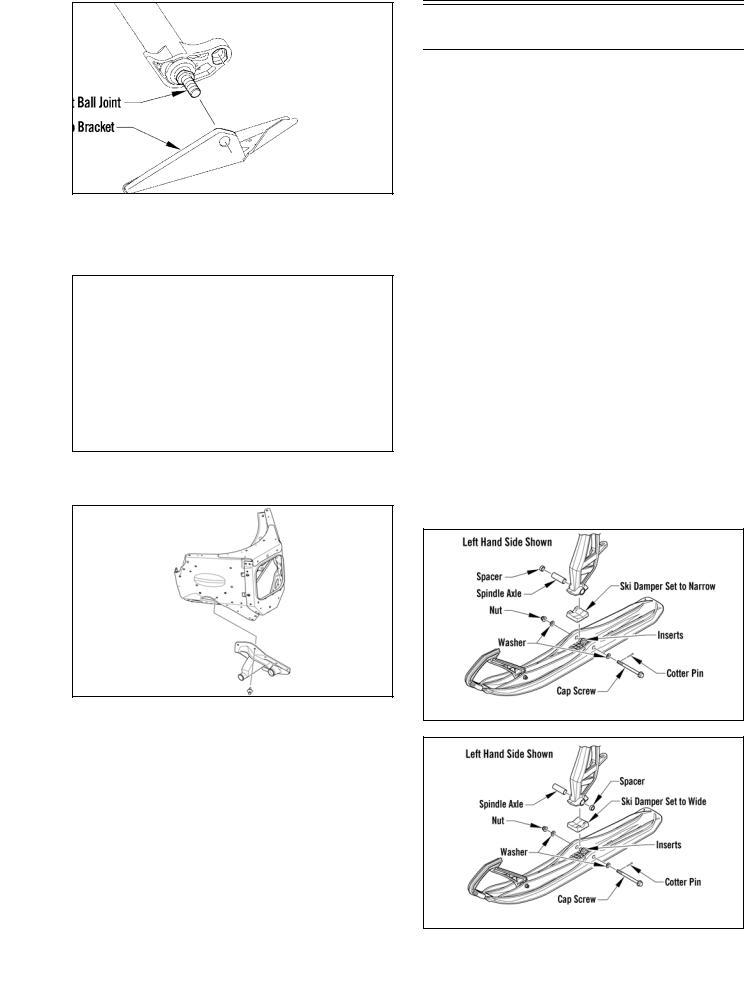
SNO-2218
2.Secure the tie rod assembly to the steering post using a new M10 nut. Be sure to align the tie rod ball joint alignment tab with the steering post. Tighten to 35 ft-lb.
SNO-2219
3.Secure the right-side steering boot to the chassis using the existing push rivets.
SNO-763
4.Secure the top of the steering post to the steering support using the existing retaining plate, steering post blocks, and nuts. Make sure the throttle cable is positioned between the steering post blocks. Tighten to 8 ft-lb.
5.Install the handlebar riser onto the top of the steering post and secure using the existing cap screws and caps. Tighten evenly to 15 ft-lb.
6.Position the hood onto the snowmobile and connect the hood harness connector and secure the two front quarter turns.
7.Install the access panels into the skid plates; then close the access panel and secure with the two quarter turns.
Ski (ZR/XF)
REMOVING
1.Elevate the front of the snowmobile and secure on a support stand.
2.Remove and discard the cotter pin; then remove the nut and cap screw securing the ski to the spindle.
NOTE: Note the orientation of the damper for installation purposes.
3.Remove the ski. Account for the rubber damper and washers.
INSPECTING
1.Inspect the ski for cracks or deterioration.
2.Inspect the ski for abnormal bends or cracks.
3.Inspect the wear bar for wear.
4.Inspect all hardware and the spindle bushings for wear and damage.
5.Inspect the rubber damper for damage or wear.
INSTALLING
1.Slide a washer onto the cap screw used to secure the ski; then apply all-temperature grease to the shaft portion of the cap screw and spindle axle.
2.Install the spindle axle into the spindle; then position the ski damper into the bottom of the ski making sure the damper is properly positioned for the desired ski stance.
0746-796
0746-797
12
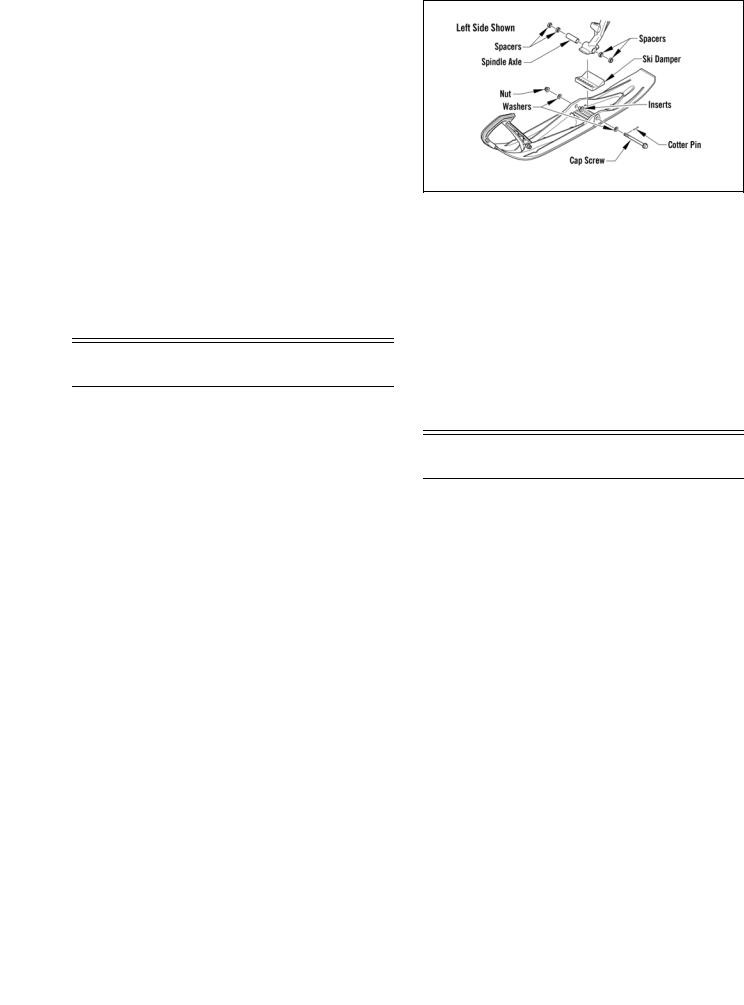
NOTE: The ski damper must be positioned in the ski so it is directly under the spindle.
3.With the cap screw hole of the ski centered with the spindle axle, slide the cap screw with washer through the outside of the ski and spindle assemblies.
NOTE: Local laws and/or regulations as to maximum width of the ski stance may be applicable. Always comply with the maximum width laws and/or regulations when adjusting ski stance.
NOTE: Install the cap screw so the lock nut will be located to the inside of the ski and the cotter pin slot in the cap screw will be horizontal with the ski.
4.Install the remaining washer and lock nut; then tighten the lock nut to 35 ft-lb.
NOTE: Assure that the cotter pin slot in the cap screw is still horizontal with the ski (see illustration); then proceed to step 5.
5.Install a new cotter pin from the back side of the ski cap screw and spread the pin.
Ski (XF HC/M)
REMOVING
1.Elevate the front of the snowmobile and secure on a support stand.
2.Remove and discard the cotter pin; then remove the nut and cap screw securing the ski to the spindle.
NOTE: Note the orientation of the damper for installation purposes.
3.Remove the ski. Account for the rubber damper, axle, spacers and washers.
INSPECTING
1.Inspect the ski for cracks or deterioration.
2.Inspect the ski for abnormal bends or cracks.
3.Inspect the wear bar for wear.
4.Inspect all hardware and the spindle bushings for wear and damage.
5.Inspect the rubber damper for damage or wear.
INSTALLING
1.Slide a washer onto the cap screw used to secure the ski; then apply all-temperature grease to the shaft portion of the cap screw and spindle axle.
2.Install the spindle axle and spacers into the spindle; then position the ski damper into the bottom of the ski making sure the damper is properly positioned for the desired ski stance.
0748-903
NOTE: The ski damper must be positioned in the ski so it is directly under the spindle.
3.With the cap screw hole of the ski centered with the spindle axle, slide the cap screw with washer through the outside of the ski and spindle assemblies.
NOTE: Install the cap screw so the lock nut will be located to the inside of the ski and the cotter pin slot in the cap screw will be horizontal with the ski.
4.Install the remaining washer and lock nut; then tighten the lock nut to 35 ft-lb.
5.Install a new cotter pin from the back side of the ski cap screw and spread the pin.
Ski Wear Bar
The ski wear bar is a replaceable bar attached to the underside of the ski. If the snowmobile is operated primarily in deep snow, ski wear bar wear will be minimal; however, if the snowmobile is operated on terrain where the snow cover is minimal, the ski wear bar will wear faster. Arctic Cat recommends that the ski wear bars be replaced if worn to 1/2 of original diameter.
REMOVING
1.Raise the front of the snowmobile and secure with a suitable stand.
2.Remove the lock nuts securing the wear bar to the ski; then remove the wear bar.
INSTALLING
1.Install the wear bar into the ski making sure it is fully seated using a rubber mallet.
2.Secure the wear bar with lock nuts. Tighten to 8 ft-lb.
13
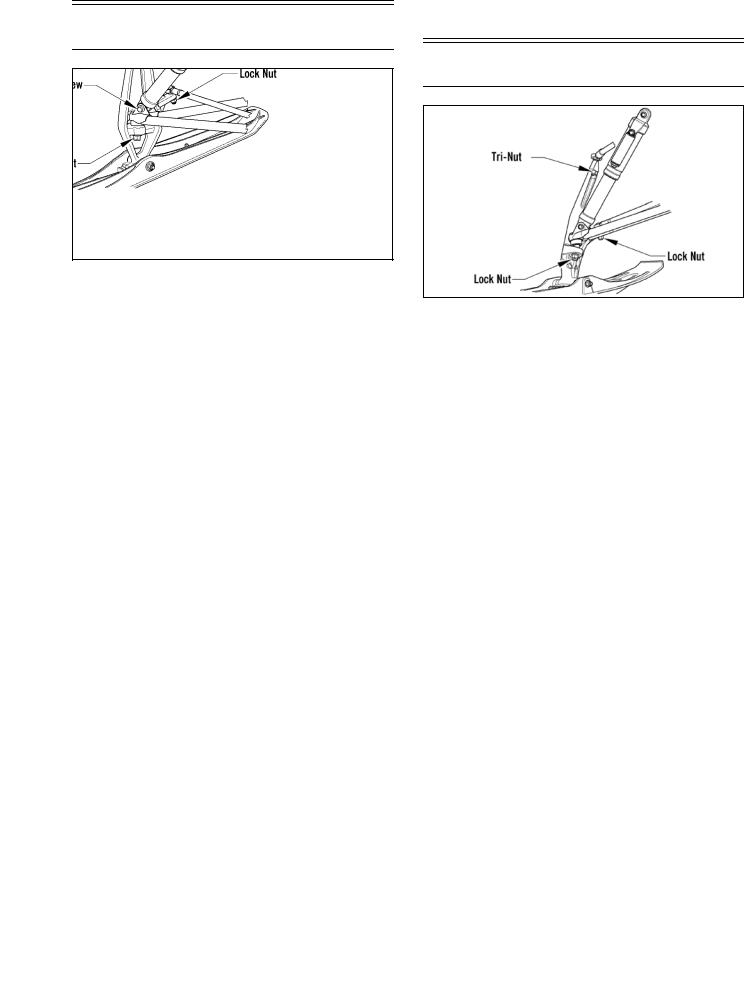
Spindle (ZR/XF)
5.Turn the handlebar fully to the right and then to the left to verify the steering moves freely.
Spindle (XF HC/M)
0747-904
REMOVING
1.Position the front of the snowmobile on a safety stand; then remove the ski.
2.Remove the cap screw and lock nut securing the shock absorber to the spindle.
3.Remove the lock nut securing the tie rod to the spindle arm. Account for the washer on the top side.
4.Remove the two lock nuts securing the spindle to the upper and lower A-arms; then using a rubber mallet, remove the arms from the spindle.
5.Remove the spindle.
INSPECTING
1.Inspect the spindle for excessive wear, cracks, bends, or imperfections.
2.Inspect the A-arm bushings and axle area for wear.
3.Inspect the ski spindle axle and bearings for wear, damage, or loose fit. Replace the bearings as a set.
NOTE: Replacing the ski bolt bushings is difficult.
The existing bushings will be damaged during removal. Be careful, however, not to damage the spindle when removing the bushings. Press the new bushings into the spindle.
INSTALLING
1.Place the shock absorber into position on the spindle. Secure with the cap screw and lock nut. Tighten to 32 ft-lb.
2.Install the upper and lower A-arms into the spindle; then remove the snowmobile from the support stand. Secure with new lock nuts. Tighten to 45 ft-lb.
NOTE: The weight of the snowmobile will allow the ball joints to seat into the spindle before tightening the nuts.
3.Place the tie rod with washer into position on the spindle arm. Secure with a new lock nut. Tighten to 32 ft-lb.
4.Install the ski.
0749-480
REMOVING
1.Position the front of the snowmobile on a safety stand; then remove the ski.
2.Remove the lock nut securing the tie rod to the spindle arm. Account for the washer on the top side.
3.Remove the machine screw and tri-nut securing the upper A-arm ball joint to the spindle.
4.Remove two lock nuts securing the spindle to the lower A-arm; then using a rubber mallet, remove the lower arm from the spindle.
INSPECTING
1.Inspect the spindle for excessive wear, cracks, bends, or imperfections.
2.Inspect the A-arm bushings and axle area for wear.
3.Inspect the ski spindle axle and bearings for wear, damage, or loose fit. Replace the bearings as a set.
NOTE: Replacing the ski bolt bushings is difficult.
The existing bushings will be damaged during removal. Be careful, however, not to damage the spindle when removing the bushings. Press the new bushings into the spindle.
INSTALLING
1.Install the lower A-arm into the spindle and loosely secure using a new lock nut.
2.Secure the upper A-arm ball joint to the spindle using the existing machine screw and tri-nut. Tighten the machine screw to 23 ft-lb.
3.Loosely install a new lock nut to secure the lower A-arm to the spindle; then remove the snowmobile from the support stand. Tighten to 45 ft-lb.
NOTE: The weight of the snowmobile will allow the ball joint to seat into the spindle before tightening the nut.
4.Place the tie rod with washer into position on the spindle arm. Secure with a new lock nut. Tighten to 32 ft-lb.
14
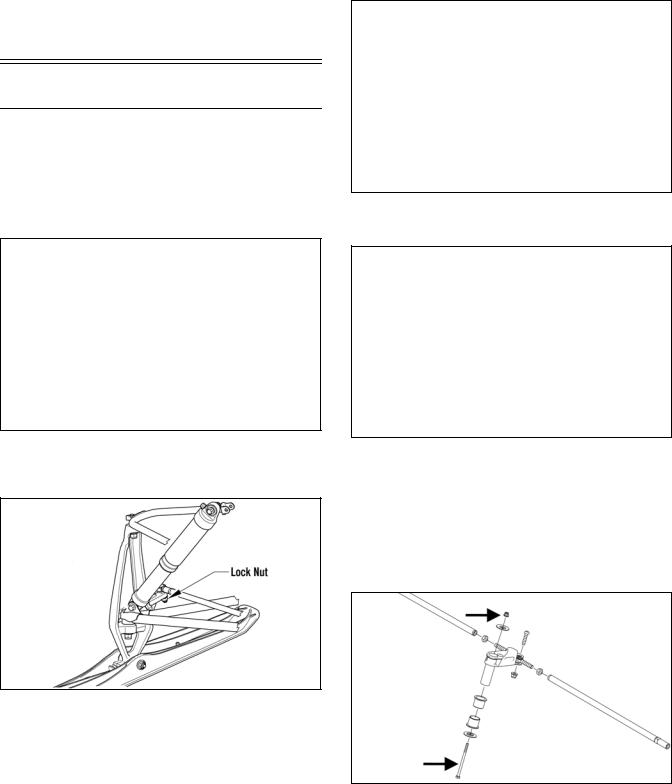
5.Install the ski.
6.Turn the handlebar fully to the right and then to the left to verify the steering moves freely.
Steering Tie Rod
NOTE: To access the steering arm, the steering tie rods must be removed.
REMOVING
1.Remove both machine screws and nyloc nuts securing the steering tie rod ends to the steering arm. Discard both nuts.
SNO-349
2.Remove the nyloc nuts securing the steering tie rod ends to the spindle arms. Account for the washers and discard both nuts.
SNO-350
5.Remove the lock nut securing the steering tie rod to the steering post. Discard the nut.
SNO-351
NOTE: At this point if the technician’s objective is to remove the steering arm, the reinforcement bracket will need to be removed by drilling out the appropriate rivets.
6.Remove all torx-head screws securing the front skid plate to the chassis; then remove the cap screw and nut securing the steering arm to the chassis. Account for two washers and two bushings.
SNO-353
3.Slide the steering tie rod out of the steering boot and out of the snowmobile.
4.Remove the screw and lock nut securing the steering tie rod end to the steering arm. Discard the nut.
SNO-829A
INSPECTING
1. Inspect the ball joints for damaged threads or wear.
2. Inspect the tie rod for damage, unusual bends, or wear.
INSTALLING
1. Secure steering arm into position and secure using the existing cap screw, flat washers, and nut. Tighten to 96 in.-lb.
15
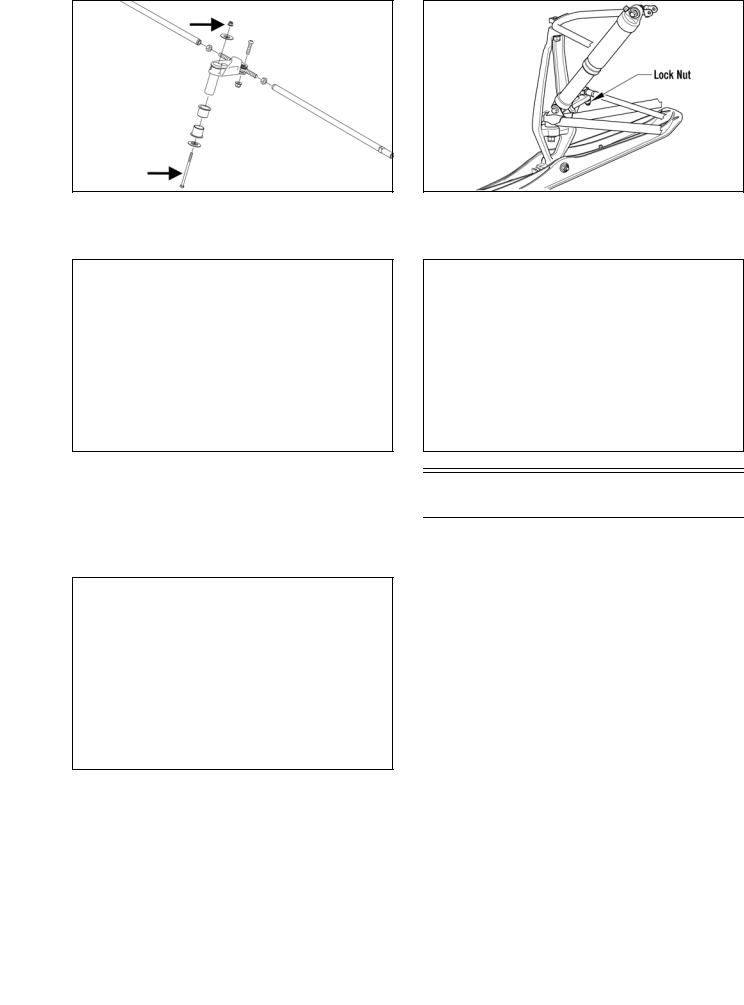
SNO-829A
2.Place the steering tie rod into position on the steering post. Secure with a new nyloc nut. Tighten to 35 ft-lb.
SNO-351
NOTE: Make sure the tie rod tab is fully seated into the steering post and threads of the ball joint are above the nut when tightened correctly.
3.Place the tie rod end into position on the steering tie rod bracket. Secure with a new nyloc nut. Tighten to 20 ft-lb.
SNO-350
4.Slide the steering tie rod through the steering boot and into the snowmobile; then place the steering tie rod into the spindle arm with the washer. Secure with a new nyloc nut. Tighten to 32 ft-lb.
SNO-353
5.Secure the steering tie rod to the steering tie rod bracket with the screw and new nyloc nut. Tighten to 20 ft-lb.
SNO-349
Ski Alignment
CHECKING
NOTE: Track tension and alignment must be properly adjusted prior to checking or adjusting ski alignment. Ski alignment must be performed on a flat, level surface. Ski toe-out must fall within the range of 1/16-1/4 in.
1.Raise the front end of snowmobile just high enough to keep the skis from contacting the floor.
2.Turn the handlebar to the straight-ahead position. Visually inspect the handlebar for being centered and in the straight-ahead position.
3.With the handlebar in the straight-ahead position, secure the handlebar to prevent the alignment from becoming disturbed during the remainder of the alignment procedure.
NOTE: Track tension and alignment must be properly adjusted prior to placing the straightedge against the outside edge of the track.
4.Place a long straightedge against the outside edge of the track so it lies near the inside edge of the left-side ski.
NOTE: The straightedge should be long enough to extend from the back of the track to the front of the ski.
16
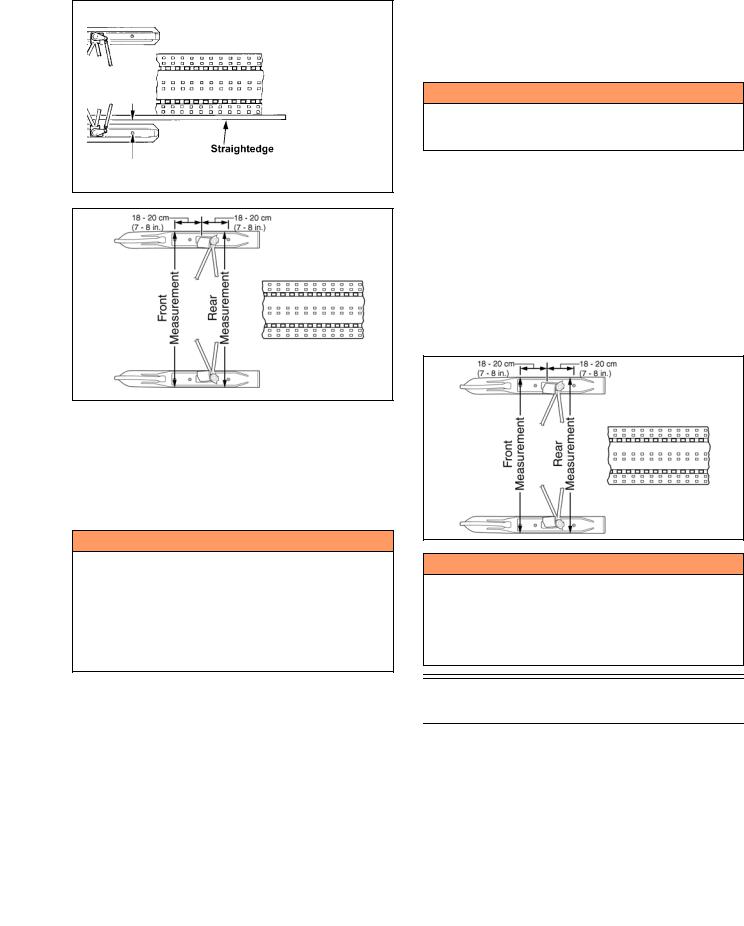
5.Measure the distance from the straightedge to the left-side ski wear bar bolts in two places: approximately 7-8 in. in front of the spindle and 7-8 in. behind the spindle. Record the measurements taken for the left side.
729-887A
0734-408
6.Place the straightedge against the outside edge of the track so it lies near the inside edge of the right-side ski.
7.Measure the distance from the straightedge to the right-side ski wear bar bolts in two places: 7-8 in. in front of the spindle and 7-8 in. behind the spindle. Record the measurements taken for the right side.
! WARNING
The measurement from the front and rear wear bar bolts to the straightedge can be equal (ski parallel to the track), but the front measurement must never be less (ski toed-in) or poor handling will be experienced. The front wear bar bolt measurement to the straightedge must not exceed the measurement from the rear wear bar bolt to the straightedge (ski toed-out) by more than 5/32 in.
8.If ski alignment is not as specified, adjust the alignment of the ski(s) not parallel to the straightedge.
ADJUSTING
NOTE: The following procedure can be used to adjust the alignment of either ski.
NOTE: The rivets securing the steering boots will have to be removed in order to adjust the inner tie rod ends.
1. Secure the steering tie rod in the centered position.
2.Loosen both spindle tie rod jam nuts on the same side as the ski to be aligned.
3.Using a wrench on the spindle tie rod “flats,” rotate the spindle tie rod until recommended specification is attained.
4.Apply blue Loctite #243 to each jam nut thread area; then tighten the jam nuts against the spindle tie rod.
NOTE: Repeat this procedure on each side (if necessary) until ski toe-out is within specification.
! WARNING
Neglecting to lock the tie rod by tightening the jam nuts may cause loss of snowmobile control and possible personal injury.
VERIFYING
1.With the handlebar in the straight-ahead position, verify ski alignment by measuring across from the outside edge of the left-side wear bar bolts to the outside edge of the right-side wear bar bolts (without using the straightedge) in two places: approximately 7-8 in. in front of the spindle and 7-8 in. behind the spindle.
2.The measurement from in front of the spindle to the outer edge of the wear bar bolts (without using the straightedge) must not exceed the rear measurement by more than 1/16-1/4 in. toe-out.
0734-408
! WARNING
The measurement taken in front of the spindle must never be less than the measurement taken behind the spindle or poor handling will be experienced. Neglecting to lock the tie rod by tightening the jam nuts may cause loss of snowmobile control and possible personal injury.
A-Arms (ZR/XF)
REMOVING
NOTE: The front bumper must be removed.
1.Elevate the front of the snowmobile and secure using a suitable support stand.
2.Remove the push rivets securing the steering boot to the chassis; then slide the boot away from the snowmobile.
17
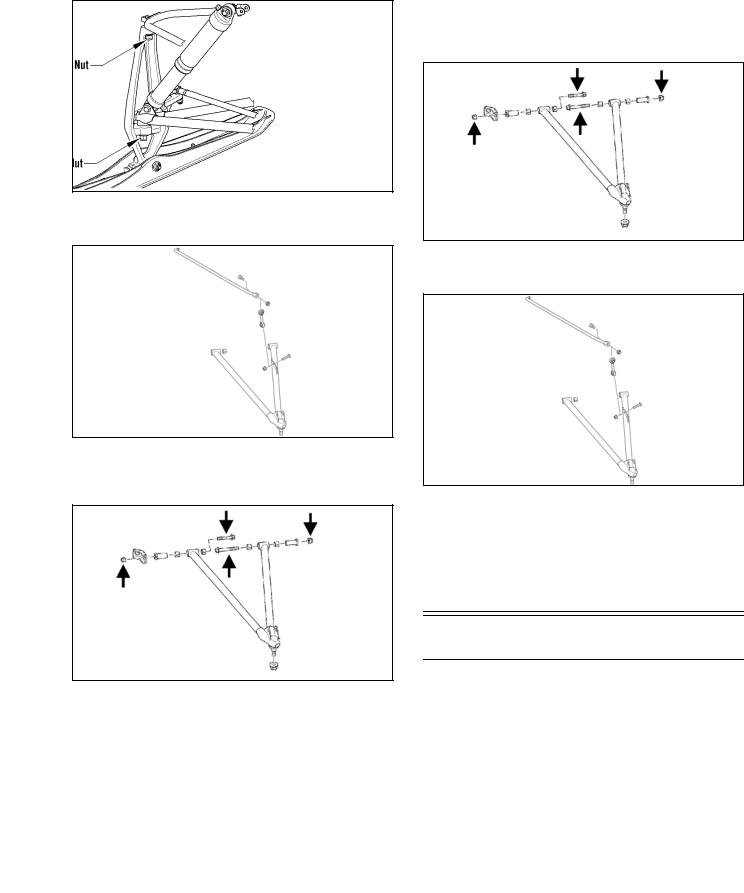
3.Remove the torx-head screws securing the front skid plate to the chassis; then remove the front skid plate.
4.Remove the ski shock absorber.
5.Remove the two lock nuts securing the spindle to the A-arms; then using a rubber mallet, remove the arms from the spindle. Discard the nuts.
4.Inspect mounting location of the chassis for cracks or wear.
INSTALLING
1.Place the upper arm into position on the chassis and secure with the cap screws and new nyloc nuts. Tighten to 23 ft-lb.
2.Slide the lower arm into the boot; then place the arm into position on the chassis. Secure with the cap screws and new nyloc nuts and tighten to 55 ft-lb (front) and 45 ft-lb (rear).
SNO-354
6.Remove the cap screw and lock nut securing the sway bar link to the lower arm. Discard the nut.
SNO-764
7.Remove the two cap screws and nyloc nuts securing the lower arm to the chassis; then slide the boot from the arm and remove the arm.
SNO-226A
8.Remove the two cap screws and lock nuts securing the upper arm to the chassis. Discard the nuts.
INSPECTING
1.Inspect the arm welded areas for cracks or any signs of deterioration.
2.Inspect the bearings and axles for wear or damage.
3.Inspect the arm tubing for signs of twisting or bending.
SNO-226A
3.Secure the sway bar link to the lower arm with the cap screw and new nyloc nut. Tighten to 23 ft-lb.
SNO-764
4.Secure the A-arms to the spindle.
5.Install the ski shock absorber.
6.Place the front skid plate into position; then secure with the torx-head screws.
NOTE: Install the front bumper.
A-Arms (XF HC/M)
REMOVING
1.Elevate the front of the snowmobile and secure using a suitable support stand.
2.Remove the push rivets securing the steering boot to the chassis; then slide the boot away from the snowmobile.
18
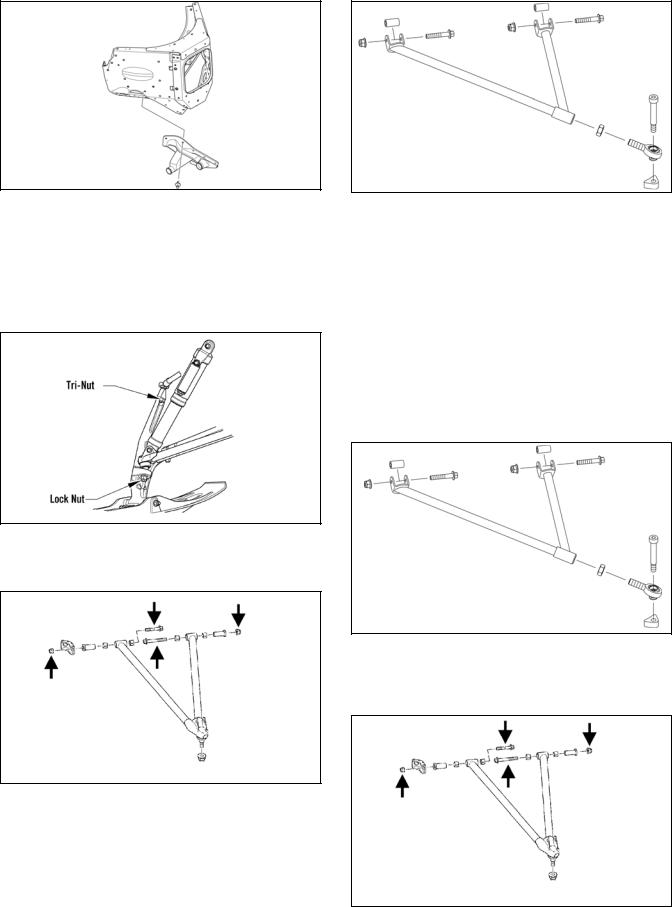
SNO-763
3.Remove the torx-head screws securing the front skid plate to the chassis; then remove the front skid plate.
4.Remove the ski shock absorber.
5.Remove the lock nut, machine screw, and tri-nut securing the spindle to the A-arms; then using a rubber mallet, remove the lower A-arm from the spindle.
SNO-572
INSPECTING
1.Inspect the arm welded areas for cracks or any signs of deterioration.
2.Inspect the bearings and axles for wear or damage.
3.Inspect the arm tubing for signs of twisting or bending.
4.Inspect mounting location of the chassis for cracks or wear.
INSTALLING
1.Place the upper arm into position on the chassis and secure with the cap screws, axles, and new lock nuts. Tighten to 23 ft-lb.
0749-480A
6.Remove the two cap screws and nyloc nuts securing the lower arm to the chassis; then slide the boot from the arm and remove the arm.
SNO-226A
7.Remove the two cap screws and lock nuts securing the upper arm to the chassis.
SNO-572
2.Slide the lower arm into the steering boot; then place the arm into position on the chassis with the existing bushings. Secure with the cap screws and new lock nuts and tighten to 55 ft-lb (front) and 45 ft-lb (rear).
PC095A
19
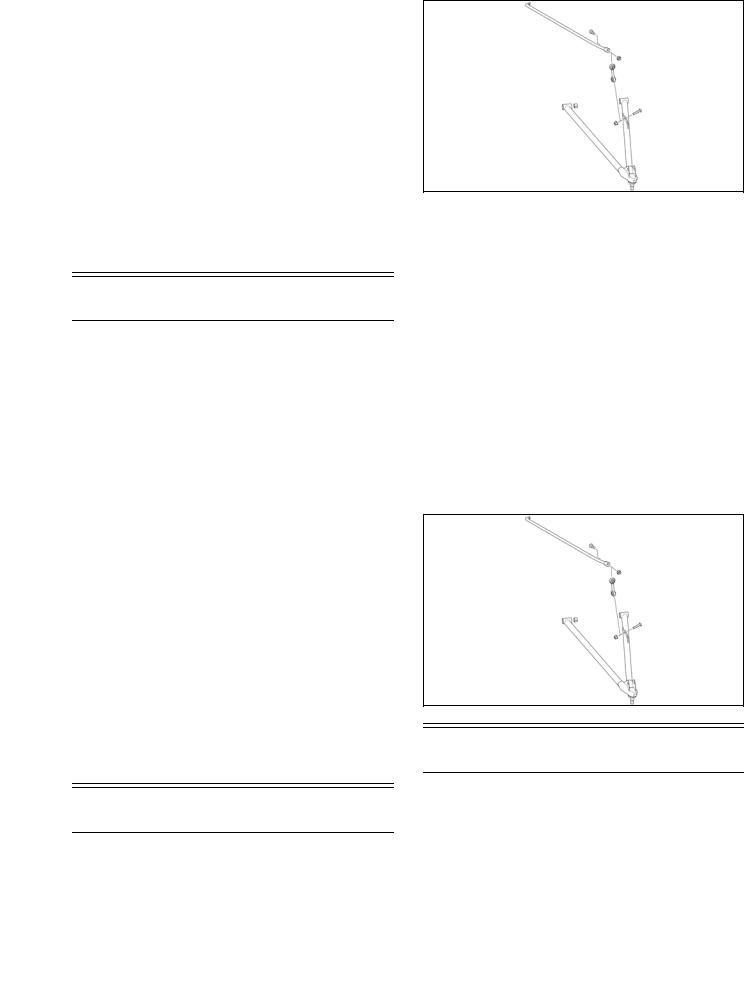
3.Secure the A-arms to the spindle using one new lock nut and one new tri nut. Tighten to the lock nut 45 ft-lb and the tri-nut to 23 ft-lb.
NOTE: If the upper A-arm ball joint is being replaced, make sure the ball joint is threaded in as far as it can. Do not adjust outward or damage to the A-arm or ball joint can occur.
4.Using a 19 mm wrench, tighten the hex nut against the upper A-arm securely making sure to keep the ball joint level with the spindle.
5.Install the ski shock absorber and secure using the existing cap screws and new lock nuts. Tighten to 24 ft-lb.
6.Install the steering boot and secure using the existing push-rivets; then place the front skid plate into position; then secure with the torx-head screws.
Ski Shock Absorber
REMOVING
1.Position the front of the snowmobile on a safety stand taking all pressure off the skis.
2.Remove the cap screws securing the shock absorber to the chassis and the lower A-arm; then remove the shock absorber. Account for all mounting hardware.
CLEANING AND INSPECTING
1.Inspect the shock absorber seal area for signs of excessive oil leakage.
2.Inspect the shock absorber mounting eyelet, bushings, and sleeve for wear or damage.
3.Inspect the threaded shock sleeve for damage or wear.
INSTALLING
1.Using the shock spring tool, place the spring on the shock absorber and secure with the retainer.
2.Adjust the retainer nut (spring adjuster) (if applicable) until the specified amount of threads are exposed between the spring adjuster and the shock housing (noted in removing) as an initial setting.
3.Install the bushings, sleeves, and spacers into each shock end; then place the shock absorber into position and secure with the cap screws and new lock nuts. Tighten the lock nuts to 32 ft-lb for ZR/XF models and 24 ft-lb for XF HC/M models.
Sway Bar
REMOVING
1.Remove the nyloc nuts and cap screws securing the sway bar link to the lower A-arm and the sway bar.
SNO-764
2.Remove the torx-head screws securing the sway bar mounting brackets; then pull the sway bar out of the snowmobile.
INSPECTING
1.Inspect the sway bar for any signs of twisting, fatigue, or wear.
2.Inspect the sway bar arms for cracks or damage.
3.Inspect the links, bushings, bushing retainers, and hardware for damage or wear.
INSTALLING
1.Place the sway bar into the sway bar mounting brackets; then install the sway bar into the snowmobile. Secure with the torx-head screws and tighten to 96 in.-lb.
2.Secure the sway bar links to the sway bar and lower A-arm with the cap screws and new nyloc nuts. Tighten to 23 ft-lb.
SNO-764
Front Bumper
REMOVING/INSTALLING
1.Remove both access panels and the hood.
2.Remove the eight torx screws and washers securing the front fascia and bumper to the chassis; then remove the front center fascia.
20
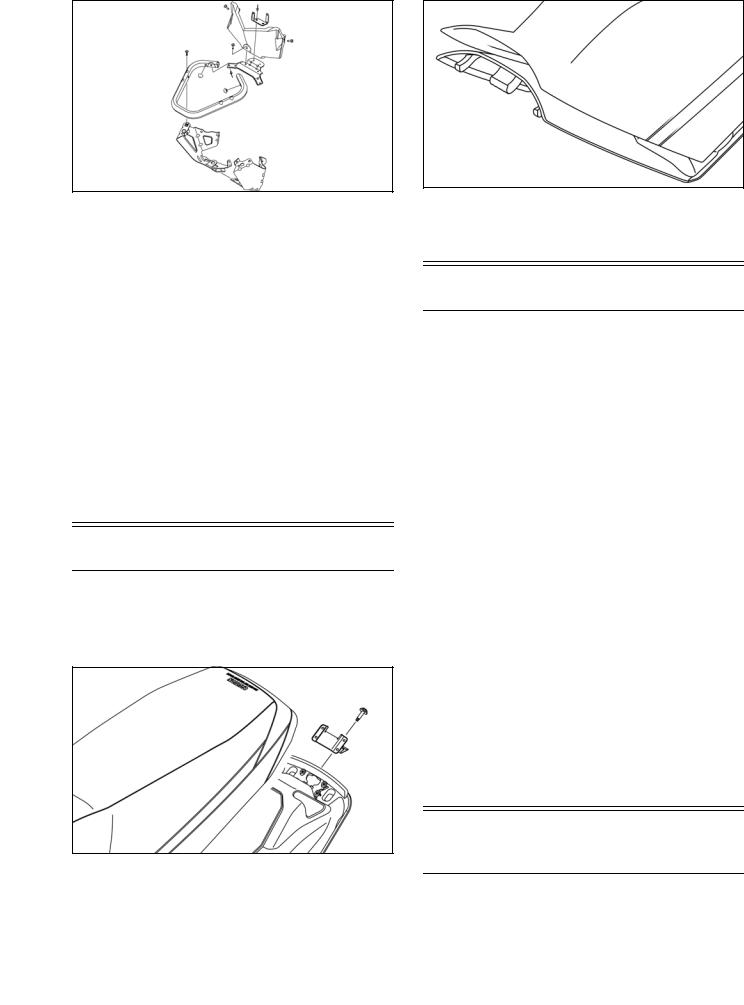
SNO-887
3.Remove the PDM from the PDM bracket; then remove the front bumper assembly.
4.Using a punch and a hammer, remove the center of the existing huck rivets securing the PDM bracket to the bumper.
5.Using a 1/4-in. drill bit, drill out the four huck rivets.
6.Secure the PDM bracket to the bottom side of the front bumper using the four huck rivets.
7.Position the front bumper assembly over the front of the snowmobile and align with the previous mounting locations.
8.Secure the bumper to the intercooler assembly using the existing four torx screws. Tighten securely.
9.Install the PDM into the PDM bracket; then position the front fascia and secure using the existing torx screws and washers. Tighten securely.
10.Install the hood and both access panels.
Seat Assembly
NOTE: On models with heated seats, be sure to disconnect the seat heater harness before removing the seat.
1.Remove the cap screw securing the rear of the seat; then remove the seat.
SNO-851
2.Route the three front tabs on the seat through the console; then install the seat and secure using the cap screw.
SNO-852
NOTE: On models with heated seats prior to lowering and securing the seat, connect the seat heater harness connector.
Seat Cushion
REMOVING
1.Remove the seat assembly.
2.Using a sharp tool, pry out all staples securing the seat cover to the plastic seat base.
3.From beneath the seat foam, remove the seat wire from the two elastic loops; then remove the cover from the seat base and seat foam.
INSTALLING
1.Position the cover over the seat foam and seat base; then pull the two elastic loops through the slots in the seat foam and secure with the seat wire. Check to make sure it is positioned straight.
2.Fold the rear edge of the cushion down and around the plastic base. Using a staple gun and 1/4 in. staples, staple the rear flap of the cushion to the plastic base in the same areas as the original staples were located. Position staples 1 in. apart.
3.Fold the sides of the cushion down around the bottom edge of the plastic seat base. Position the staples in the same area as the original staples were located.
NOTE: Note the cushion fit. If any wrinkles are noted, remove by pulling the cushion material in the appropriate direction before securing with staples.
4.Fold the front cushion material back and onto the plastic seat base. Check for wrinkles and secure with staples and two screws.
5.Install the seat assembly.
Taillight/Brakelight
Assembly
1.Remove the two machine screws securing the taillight to the taillight support; then disconnect the taillight harness connector.
21
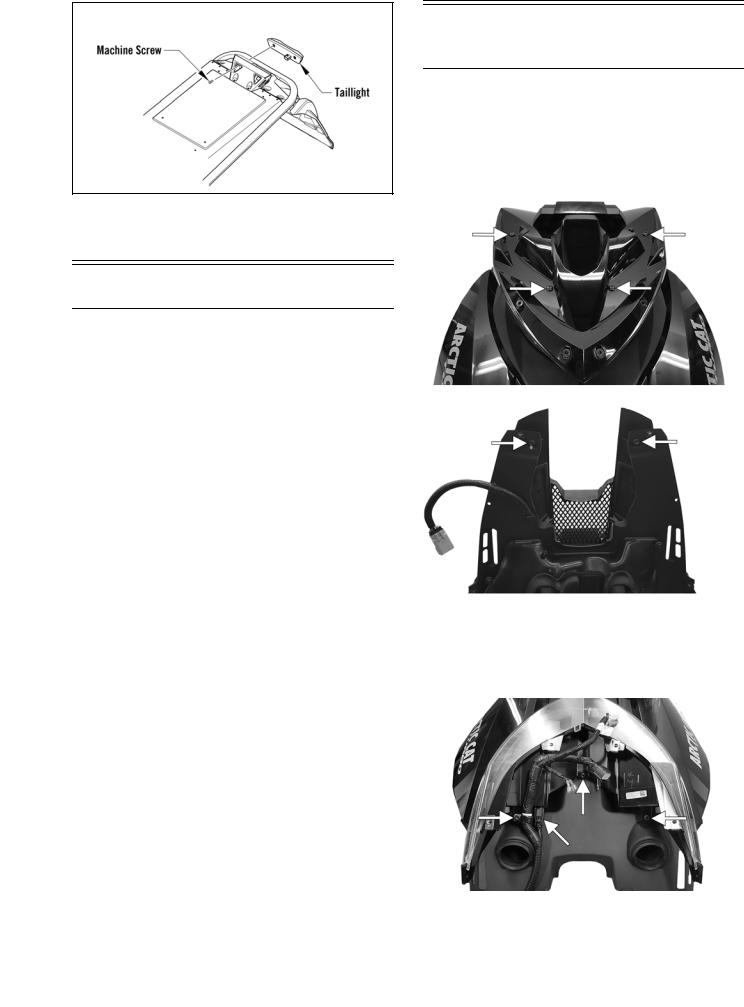
SNO-511
2.Connect the taillight harness connector; then secure the taillight to the taillight support with the two machine screws. Tighten to 48 in.-lb.
Rear Bumper/Snowflap
REMOVING BUMPER
1.Remove and retain only the two machine screws securing the rear of the skid frame assembly.
2.Place cardboard or a suitable substitute on the floor to protect the snowmobile from being scratched; then install Steering Post Stand for the standard steering models or Handlebar Stand for the adjustable steering models into the lower holes in the handlebar riser (from the left-side) and tip the snowmobile onto its left side.
3.Swing the skid frame assembly away from the chassis; then using a 3/16-in. drill bit, remove all rivets securing the left-side of the bumper; then repeat for opposite side.
4.Remove and retain the two machine screws and nuts securing the front of the existing bumper to the chassis.
5.Remove the two rivets securing the snowflap to the bumper. Remove the bumper.
INSTALLING BUMPER
1.Align the holes in the bumper with the existing holes in the tunnel; then using new rivets, secure rear bumper to the tunnel; then secure the snowflap to the rear bumper using new rivets.
2.Secure the front of the bumper to the chassis using the existing machine screws and nuts. Tighten securely.
3.Install skid frame assembly using two existing machine screws. Tighten securely.
REMOVING SNOWFLAP
1.Drill out the rivets securing the snowflap to the tunnel; then remove the snowflap.
INSTALLING SNOWFLAP
1.Secure the snowflap to the tunnel using the appropriate rivets.
Windshield/Console/
Headlight
REMOVING
1.Remove both access panels and the hood.
2.Remove the six screws securing the windshield to the console; then remove the windshield.
3.Remove the six screws securing the console.
XM541A
XM542A
4.Disconnect the gauge, electrical accessory wires, and the ignition switch.
5.Remove the three screws securing the headlight to the hood; then disconnect the headlight connector. Remove the headlight.
XM543A
22
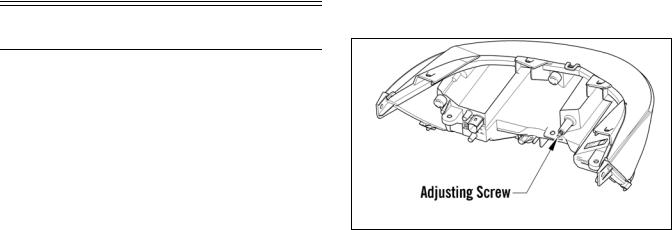
INSTALLING
1.Position the headlight onto the hood; then secure the headlight using the existing screws. Connect the headlight connector.
2.Engage the side console tabs on the headlight assembly; then place the front of the console over the headlight assembly and press down until it snaps in place.
3.Secure the console to the headlight and the hood using the existing screws. Tighten securely.
4.Connect the gauge; then connect the electrical accessory wires and the ignition switch.
5.With the windshield in position, secure the windshield to the frame using the six screws. Tighten securely.
6.Install the hood and both access panels.
Adjusting Headlight Aim
The headlight can be adjusted for vertical aim of the HIGH/LOW beam. The geometric center of HIGH beam zone is to be used for vertical aiming.
1.Position the snowmobile on a level floor so the headlight is approximately 25 ft from an aiming surface (wall or similar surface).
NOTE: There should be an “average” operating load on the snowmobile when adjusting headlight aim.
2.Measure the distance from the floor to midpoint of the headlight.
3.Using the measurement obtained in step 2, make a horizontal mark on the aiming surface.
4.Make a vertical mark intersecting the horizontal mark on the aiming surface directly in front of the headlight.
5.Engage the brake lever lock and start the engine. Select the headlight dimmer switch HIGH beam position. DO NOT USE LOW BEAM.
6.Observe the headlight beam aim. Proper aim is when the most intense beam is centered on the vertical mark 5 cm (2 in.) below the horizontal mark on the aiming surface.
7.Adjust the headlight using the adjusting screw on the backside of the headlight housing until correct aim is obtained. Shut the engine off; then disengage the brake lever lock.
0750-309
23
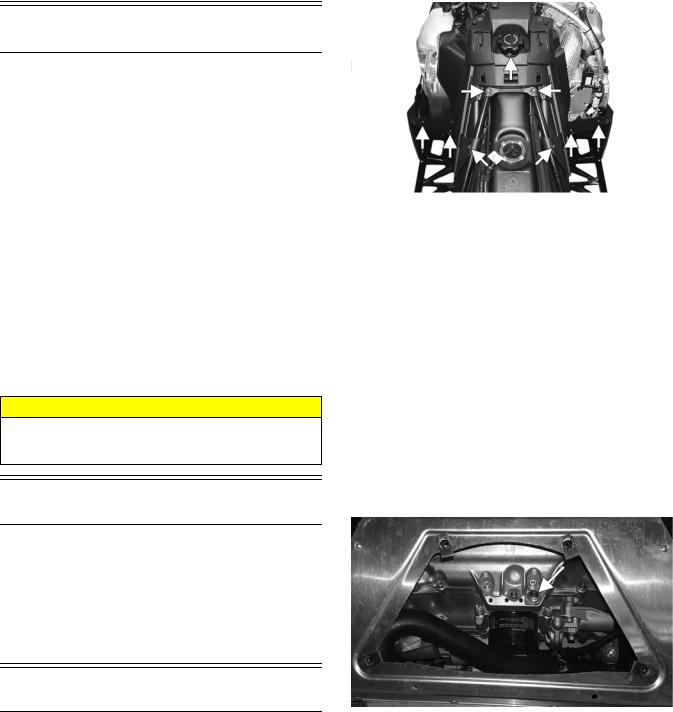
Engine
NOTE: Whenever a part is worn excessively, cracked, or damaged in any way, replacement is necessary.
SPECIAL TOOLS
A number of special tools must be available to the technician when performing service procedures in this engine section.
NOTE: When indicated for use, each special tool will be identified by its specific name, as shown in the chart below, and capitalized.
Description |
p/n |
|
|
Drive Clutch Bolt Tool |
0644-281 |
|
|
Drive Clutch Puller |
0744-062 |
|
|
Drive Clutch Spanner Wrench |
0644-136 |
|
|
Engine Lift Plate |
0744-073 |
|
|
Hood Harness Extension |
1686-659 |
|
|
NOTE: Special tools are available from the Arctic
Cat Service Parts Department.
CAUTION
Never attempt to substitute any other drive clutch puller for the recommended puller or severe clutch or crankshaft damage will occur.
Engine Removing/ Installing
This engine sub-section has been organized to show a progression for the removing/installing of the Arctic Cat 998 cc engine. For consistency purposes, this sub-section shows a complete and thorough progression; however, for efficiency it may be preferable to remove only those components needing to be addressed. Also, some components may vary from model to model. The technician should use discretion and sound judgment.
Removing
NOTE: While removing the engine, note all cable tie locations.
1.Remove both access panels; then loosen the two quarter turns securing the hood. Disconnect the hood harness and pull the hood forward and off of the snowmobile.
2.Remove the seat; then remove the gas cap and retaining nut from the neck of the gas tank. Remove the eight screws securing the console. Remove the console.
YM-176A
3.Remove the gas tank assembly.
4.Remove the cap screw from the secondary sheave and slide the secondary sheave (along with the drive belt) off the driven shaft. Account for alignment washers and sheave adjuster.
5.Remove the cap screw and washer securing the primary sheave to the crankshaft.
6.Using Primary Sheave Puller, tighten the puller. Remove the primary sheave.
NOTE: If the primary sheave will not release, sharply strike the head of the puller. Repeat this step until the sheave releases.
7.Remove the torx-head screws and both access plates from beneath the snowmobile.
8.Place a drain pan beneath the engine oil drain screw; then remove the screw and allow the oil to drain completely. After the oil has drained, install the drain plug and tighten to 10 N-m (1 kg-m, 7.2 ft-lb).
YM-152A
9.Remove the four torx-head screws securing the right-side footrest to the tunnel and the support; then with a drain pan in position, remove the drain plug from the oil tank.
24
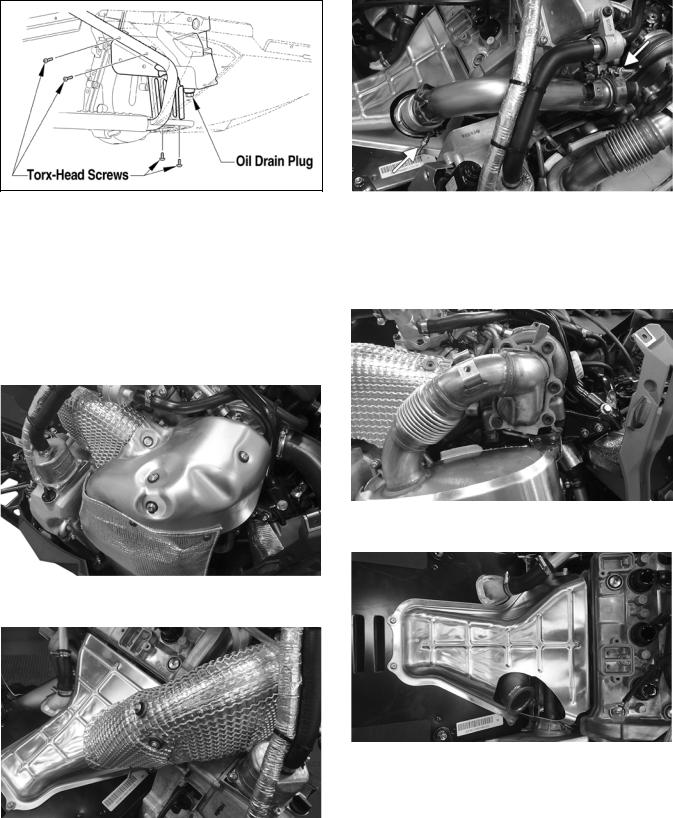
746-121A
NOTE: To aid in draining the oil from the reservoir, position a funnel between the tank and the opening of the tunnel running board.
10.After the oil has drained completely, install the drain plug with a new O-ring and tighten to 22 N-m (2.2 kg-m, 16 ft-lb).
11.Using a suitable vacuum pump, remove the coolant from the coolant filler neck and the reservoir tank.
12.Remove the five screws and washers securing the turbo heat shield to the turbo. Remove the shield.
YM-181
13.Remove the cap screws and washers securing the heat shield to the manifold.
YM-155
14.Apply a small amount of penetrating lubricant to the threads of the two clamp threads; then remove the two nuts securing the exhaust pipe clamps. Remove the clamps and the pipe.
YM-182A
15.Remove the six torx screws securing the resonator to the turbo; then remove the spring securing the resonator. Remove the resonator and account for a gasket.
NOTE: A long T50 ball head torx bit (p/n 0644-623) will be needed to remove the torx screws.
YM-154
16.Remove the screws and washers securing the exhaust heat shield to the tunnel.
YM-157
17.Remove the hose clamps securing hoses to the turbo, intake manifold, intercooler, and the air bypass valve. Remove both hoses.
25
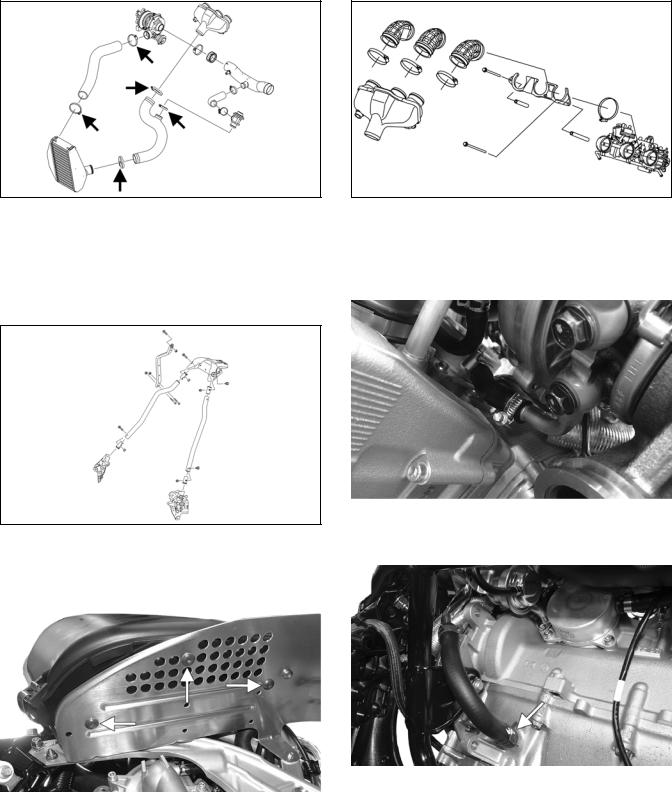
SNO-835A
18.Remove the steering post assembly; then remove the two cap screws and nuts securing the vapor tank to the right-side support.
19.Remove the cap screws securing the front spars to the chassis; then remove the cap screws and nuts securing the right-side support to the chassis. Remove the steering support as an assembly.
SNO-836
20.Remove the screws securing the air silencer to the clutch guard; then disconnect the hose from the top of the engine and the waste gate hose. Remove the air silencer assembly.
YM-185A
21.Remove the two cap screws and spacers securing the intake manifold and throttle body to the engine; then remove the three clamps securing the intake boots to the throttle body. Remove the intake manifold.
SNO-837
22.Remove the clamp securing the intake duct to the PTO-side of the turbo.
23.Remove the hose clamp securing the coolant hose to the vapor tank; then remove the hose clamp securing the coolant hose from the bottom of the turbo.
YM-164
24.Remove the clamp securing the oil return hose to the crankcase; then remove the oil delivery hose to the cylinder. Account for two washers.
YM-165A
26
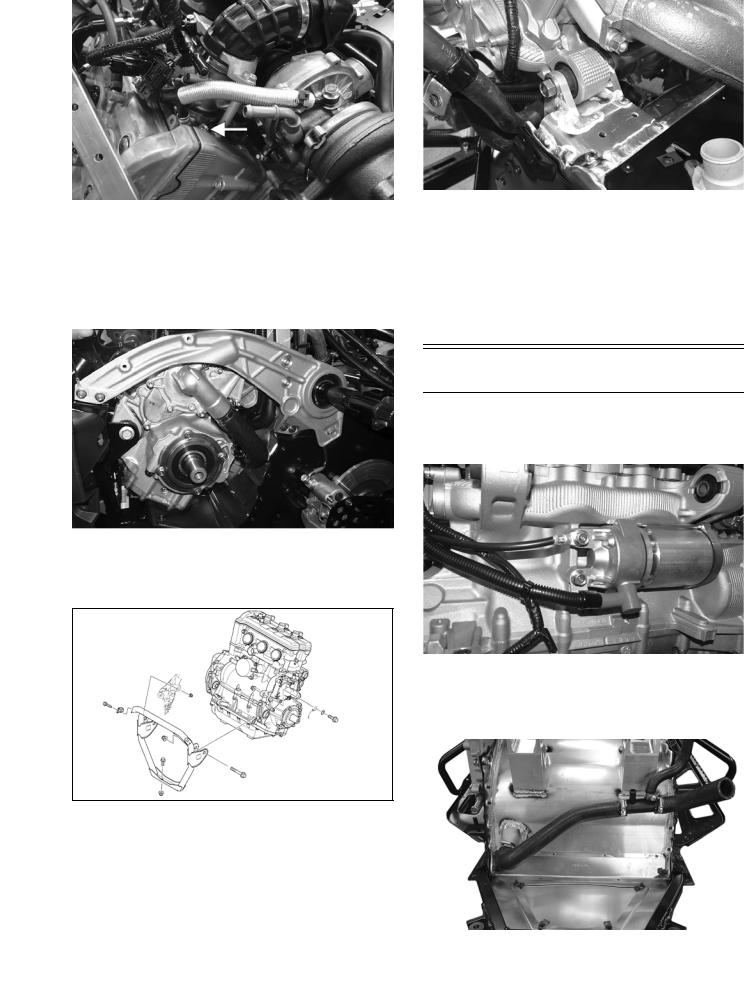
YM-163
25.Remove the four cap screws and four nuts securing the right-side chassis support to the chassis. Remove the turbo and support assembly.
26.Remove the three screws and one nut securing the clutch guard; then remove the screws and nuts securing the left-side chassis support. Rotate the support up to gain access to the rear engine cap screw.
YM-160
29.Remove the clamp securing the MAG-side coolant hose to the engine; then disconnect the oil pressure switch and the oil pressure sensor.
30.With all hoses and wires disconnected from the engine, move the engine forward and out the right-side of the chassis.
31.Remove the throttle body assembly once the engine is removed.
Installing
NOTE: Before installing the engine, be sure the starter motor and cables are installed and secured to the engine.
YM-186
27.Remove all six cap screws and nuts securing the front engine bracket; then remove the bracket. Remove the cap screw and nut securing the ground wire to the engine.
SNO-364
28.Remove the cap screw and nut securing the rear of the engine to the chassis.
YM-162
NOTE: If the thermostat-to-heat exchanger coolant hose was removed, make sure it is properly routed and installed onto the heat exchanger. Tighten to 4 N-m (0.4 kg-m, 35 in.-lb).
YM-159
27
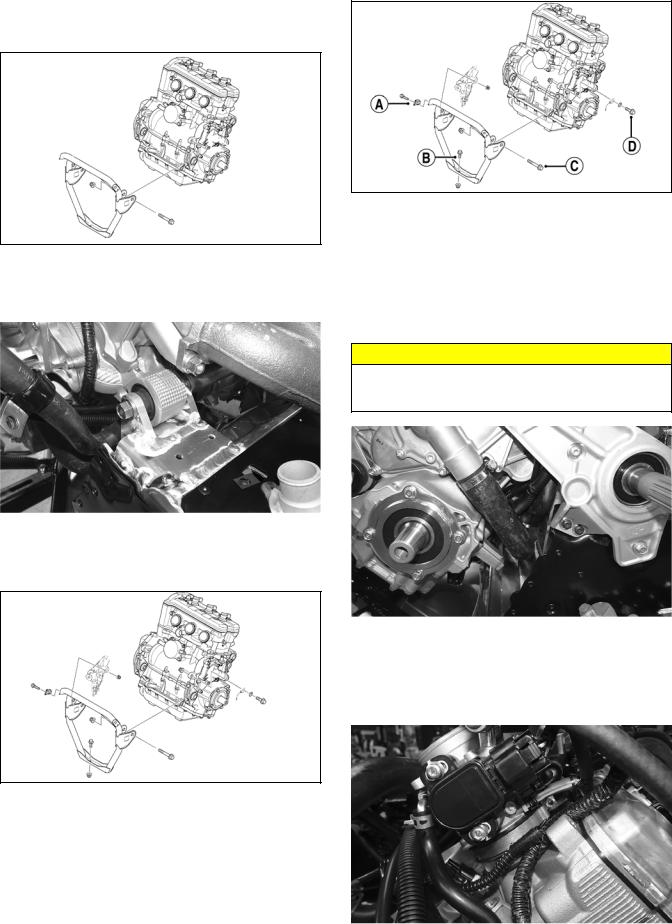
1.Position the front engine bracket with the front engine mounts; then loosely secure using the existing cap screws and new nuts.
SNO-365
2.Carefully lower the engine into the chassis aligning the rear engine mounts with the chassis mounts; then loosely secure using the existing cap screw and a new nut.
SNO-364A
6.Connect the oil pressure switch and the oil pressure sensor to the main harness.
7.Connect the coolant hose from the heat exchanger to the water pump and secure using the existing hose clamp. Tighten to 4 N-m (0.4 kg-m, 35 in.-lb).
NOTE: All wires, cables, and hoses must be installed on the inside of the coolant hose and the PTO-side bracket.
CAUTION
Make sure the top clamp is routed like the image below so the clamp does not come in contact with the primary sheave.
YM-160
3.Loosely secure the front engine mounting bracket to the chassis using the existing cap screws and new nuts; then loosely secure the ground cable to the engine using the existing cap screw and a new nut.
YM-161
NOTE: Route the positive and negative battery cables up and over the engine mounts.
8. Install the throttle body assembly into the three intake boots and secure using the existing clamps. Tighten to 3 N-m (0.3 kg-m, 26 in.-lb).
SNO-364
4.Tighten the rear engine cap screw and nut to 126 N-m (12.8 kg-m, 93 ft-lb).
5.Tighten the cap screws (A and B) to 34 N-m (3.5 kg-m, 25 ft-lb). Tighten cap screws (C) to 88 N-m (8.9 kg-m, 65 ft-lb). Tighten cap screw (D) to 41 N-m (4.2 kg-m, 30 ft-lb).
YM-168
28
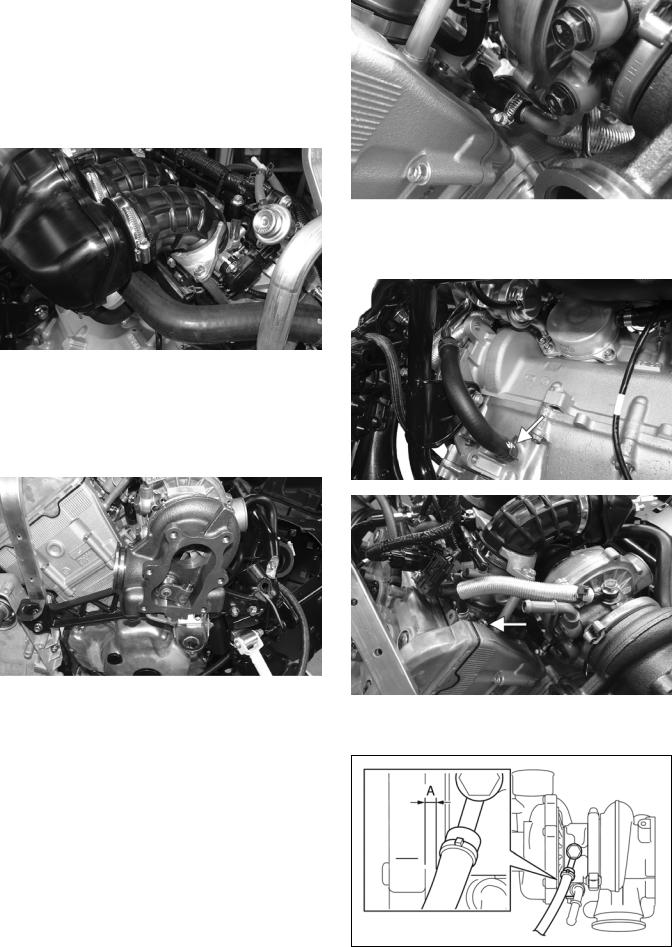
9.Install the throttle body coolant hoses to the engine and the water pump. Secure using the existing clamps.
10.Install the intake manifold assembly onto the throttle body assembly and secure using the existing clamps. Tighten to 2.4 N-m (0.24 kg-m, 20 in.-lb).
11.Secure the manifold bracket to the engine using the existing cap screws and spacers. Tighten to 10 N-m (1.0 kg-m, 7.2 ft-lb).
YM-169
12.Position the right-side rear spar with the chain case assembly; then install the existing cap screws through the chain case and the spar.
13.With the turbo installed onto the MAG-side mounting bracket; secure the assembly to the chassis using the existing screws and nuts. Tighten to 27 N-m (2.8 kg-m, 20 ft-lb).
YM-163
14.Connect the lower coolant hose on the backside of the turbo to the oil cooler. Secure using the existing hose clamp. Tighten to 3.5 N-m (0.35 kg-m, 35 in.-lb.
YM-164
15.Secure the oil return hose to the crankcase using the existing clamp; then secure the oil delivery hose to the cylinder using the existing banjo bolt and new washers. Tighten to 10 N-m (1.0 kg-m, 7.2 ft-lb).
YM-165A
YM-163
NOTE: Make sure the distance (A) between the oil delivery hose and the turbo is 3.0 mm (0.12 in.).
SNO-821
29
